Web series 'Star Trek: Phase II' gets new home, new Kirk
Crave's Michael Franco talks with Assistant Director Dennis Hotston about the new digs and the new actor, called by some fans "a better Captain Kirk than Captain Kirk."

Forty-five years ago this week, NBC cancelled a TV series that boldly took viewers to a place they'd never been before, ending what was to be a five-year mission for the Starship Enterprise. But that in no way grounded the explorations of Kirk and crew -- since that date, the Star Trek franchise has launched a dozen movies, four TV shows (not counting the animated series), and at least two fan fiction Web series.
I wrote about one of these -- " Star Trek Continues " -- recently on Crave, and was soon contacted by Trekkies everywhere to make sure I knew about an even longer-running Trek spin-off called " Star Trek: Phase II ." I'm happy to say that now, after a talk with Dennis Hotston, first assistant director, I know lots about it as well.
First launched in 2003, the Web series is named after a reboot of the TV series that was planned by Paramount but got scrapped in favor of its first "Star Trek" movie. Thus far, the series has produced nine episodes and is about to release its 10th in the next few months.
That episode, called "The Holiest Thing," will also be the first to star Brian Gross as a new Captain Kirk, who was formerly played by James Cawley, the show's senior executive producer. Gross has appeared in a variety of TV shows, including "NCIS: Los Angeles," "CSI: NY," and "Saving Grace," and done voice work on the video game Star Wars: The Old Republic. Hotston says that when fans saw the new episode starring Gross at a private screening, some commented that "he was a better Captain Kirk than Captain Kirk."
The thing that has the "Phase II" crew the most excited these days is that they're in the process of moving into a new studio in Ticonderoga, N.Y. Hotston says that it's a big step up after having filmed for years in a converted car dealership. "James Cawley has the original blueprints from Desilu ," he told me. "Not reproductions -- but the real blueprints -- and we are building those sets exactly as they were at Desilu Studios in 1966."
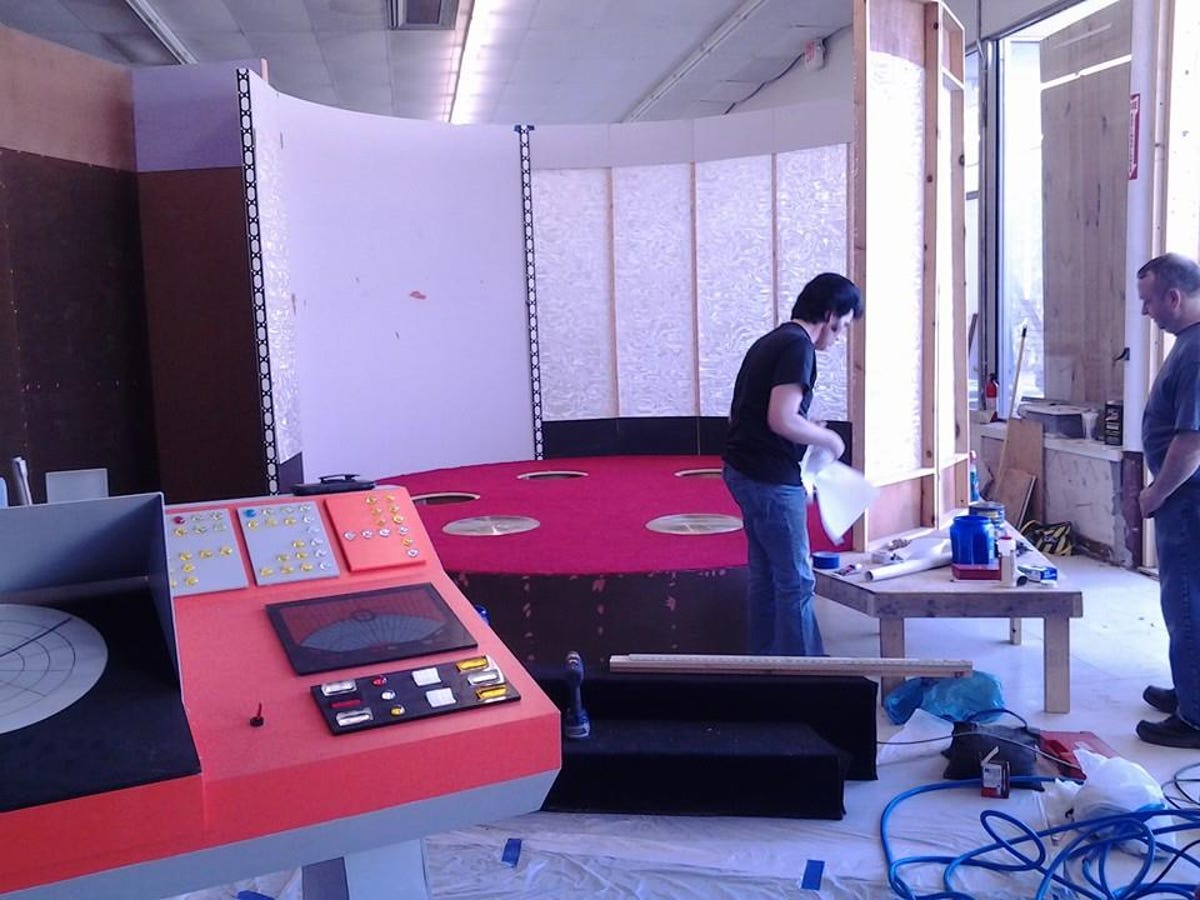
The warehouse in which the sets are being built covers 13,000 square feet. The bridge, corridors, and transporter room are pretty much completed at this point, Hotston says, adding that once those are ready, a new episode called "Mind Sifter" will begin filming there.
To help with funding the studio expansion, and to raise funds to continue producing the fan-based series, the "Phase II" folks have launched a Kickstarter campaign . They shattered their $10,000 goal, having raised over $46,000 to date, but they're still trying to hit bigger goals with six days left in the campaign. The funds will not only be used for the studio move, but to produce future episodes, which the creators say cost about $15,000 each to make.
Even though fans can now contact the production and ask for permission to see the sets, some day the new studio might be made available to the general public for tours. "It's an amazing feeling to step up to the sets because James Cawley has such a such a great eye for detail. Things like the paint colors, the trim...all these things are exactly like they were in the '60s. He's taken years to find props for Kirk's quarters, and just little things like that make all the difference when the episode hits the air."
Until the next episode is ready, Hotston says fans can get a peek at the new Captain Kirk in this clip. Live long and prosper.


Star Trek: Phase II
- View history
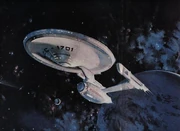
A drawing of the Enterprise , refitted for Phase II
Star Trek: Phase II , also known by its official title Star Trek II (not to be confused with the earlier 1975-1976 revitalization attempts bearing the same title), was planned to be the first live-action spin-off television series of Star Trek: The Original Series . While ultimately not realized, it did serve, in more ways than one, as the starting point for its immediate successor Star Trek: The Motion Picture .
- 2 Production
- 3.1 "In Thy Image"
- 3.2 "Tomorrow and the Stars"
- 3.3 "The Child"
- 3.4 "Cassandra"
- 3.5 "Kitumba"
- 3.6 "Practice in Waking"
- 3.7 "Deadlock"
- 3.8 "The Savage Syndrome"
- 3.9 "Are Unheard Melodies Sweet?"
- 3.10 "Devil's Due"
- 3.11 "Lord Bobby's Obsession"
- 3.12 "To Attain the All"
- 3.13 "The War to End All Wars"
- 4.1 "Ghost Story"
- 4.2 "Merlin's Magic"
- 4.3 "Paradise Lost"
- 4.4 "The Prisoner"
- 5.1 James T. Kirk
- 5.3 Will Decker
- 5.5 Leonard McCoy
- 5.6 Montgomery Scott
- 5.10 Christine Chapel
- 5.11 Yeoman
- 6 Merchandise gallery
- 7.1 Production staff
- 7.2 Uncredited production staff
- 7.3 Uncredited production companies
- 8 Further reading
- 9 Special features
- 10 External link
History [ ]
In 1977 , Paramount Pictures President Barry Diller began working on the idea of launching a new, fourth television network, officially announced on 10 June 1977 as "Paramount Television Service" (PTVS). Following the rapid growth of Star Trek fandom , and a general growing interest in science fiction programming, Diller, who had just pulled the plug on the Star Trek: Planet of the Titans movie project, revived the property by drawing up plans to launch a new Star Trek television series as the network's flagship program, covering a second five-year mission. Having been passed over for Planet of the Titans , Gene Roddenberry was brought back to serve as writer and executive producer for the new series. The Enterprise was to be refit , and new characters were to be introduced. By August , construction on the sets had begun, and the Star Trek II Writer's/Director's Guide was published on 12 August 1977 , with the premiere expected in spring of 1978 .
Unfortunately, with pre-production in full swing and filming of the feature-length pilot, " In Thy Image " scheduled to begin on 28 November 1977, the network deal already fell through in late July 1977 as Gulf+Western head, Charles Bluhdorn , thought the project would lose too much money due to lack of advertiser interest (though the studio did contribute programming to the syndicated programming service Operation Prime Time, and used the intended PTVS logo for some OPT programs, and, with a new beginning added on, as a logo for their home video division). Something of a pet project of Bluhdorn, who had become enamored with Star Trek due to the unexpected success of The Original Series in syndication, he allowed subsidiary Paramount to continue working on the pilot in order to recoup the costs already underwritten as it was furthest in development, while scrapping every other production concept for the abandoned network, including George Pal 's proposed War of the Worlds television series, based on his classic 1953 Paramount film of the same title, that was to serve as back-up for Phase II . However, the Star Trek project was now to be limited to a medium-sized stand-alone television film only. Yet, influenced by the huge success of Star Wars , which studio executives had at first thought to be a fluke, the decision was made on 21 October 1977 to upgrade the project to a full-fledged major theatrical feature, which quickly became known as Star Trek: The Motion Picture . ( Star Trek Phase II: The Lost Series , pp. 21-22, 34, 49, 69; Star Trek Movie Memories , pp. 59, 77-78)
Several scripts already completed were later used as episodes of Star Trek: The Next Generation . In fact, many of the series concepts from Phase II became the basis of The Next Generation , such as the "lost love" relationship between new first officer Decker and Ilia, which led to similar scenes in TNG's first season between Riker and Troi .
In 1997 , the reference book Star Trek Phase II: The Lost Series , written by Judith and Garfield Reeves-Stevens , was published, containing the original scripts for "In Thy Image" and " The Child ", and synopses of the original story treatments for the other commissioned stories.
In 2007 , in the It's A Wrap! sale and auction , an assortment of Phase II costumes were auctioned off. A large portion of these costumes were purchased by James Cawley for the fan-made series Star Trek: New Voyages (which has since been re-named Star Trek: Phase II ). Another costume which was sold off on IAW was previously used in the television series Mork & Mindy . [1] An olive-colored costume from the series was included in the displays at Star Trek: The Exhibition , in Blackpool.
Production [ ]
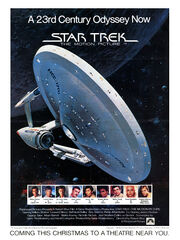
Early The Motion Picture teaser poster, still featuring the Phase II Enterprise
The refit of the original Enterprise formed an integral part of the plot of "In Thy Image". Originally, designer Ralph McQuarrie – best known to the public for his production designs for the Star Wars films – was invited to England to work under Ken Adam to help develop the designs for the Star Trek: Planet of the Titans movie project, ultimately abandoned to make way for Phase II , the television series.
Their Enterprise design, however, was abandoned, and Gene Roddenberry asked Original Series veteran Matt Jefferies , who only agreed to work on Phase II on a temporary basis (and who had actually already worked on PTVS's The War of the Worlds back-up production), to update the famous starship to reflect the refit that the ship had undergone. Jefferies' redesign changed the engine nacelles from tubes to thin, flat-sided modules, and tapered their supports. He also added the distinctive photon torpedo ports on the saucer connector. " Basically, " Jefferies said, " what I did to it was change the power units, and make a slight change in the struts that supported them. I gave the main hull a taper, then I went flat-sided and thin with the power units, rather than keeping the cylindrical shape. Trying to work out the logic of the refit, I knew a lot of the equipment inside would change, but I didn't see that there would be any need to change the exterior of the saucer. Certainly, though, the engines would be a primary thing to change. Part of the theory of the ship's design in the first place was that we didn't know what these powerful things were or how devastating it would be if anything went awry, so that's why we kept them away from the crew. And that meant they could be easily changed if you had to replace one. " After Jefferies had to return to his regular job, Mike Minor and Joe Jennings continued to refine Jefferies' redesign up to the point where detailed construction plans for the filming model could be drawn up. ( Star Trek Phase II: The Lost Series , pp. 26-27)
Unlike the first redesign of the Enterprise , Jefferies' new version was built this time by Don Loos , supervised by Brick Price of Brick Price Movie Miniatures , to whom Magicam, Inc , the company contracted at the start of September 1977 to provide all the visual effects (VFX) for the upcoming television project, had subcontracted the construction of the "hero" model . ( Starlog , issue 27, p. 26) But when Paramount abandoned its plans to create a fourth television network and subsequently began in December 1977 transforming the pilot episode " In Thy Image " of the third Star Trek series into the first movie, that the six-foot Enterprise model, along with other Phase II studio models Magicam had already built or was in the process of building, were scrapped as a new art director – Richard Taylor of Robert Abel & Associates , the company contracted the subsequent month to do the VFX for the feature film – was brought in and who assigned Andrew Probert to do a second (co-)redesign with him of the ship, essentially keeping with Jefferies' new lines, while adding the extensive detail that was necessary for motion picture big screen requirements. ( Star Trek: Creating the Enterprise , p. 46) Magicam, a Paramount subsidiary, was however retained to rebuild most of the studio models for the feature film, including the new, larger eight-foot refit- Enterprise studio model .
Aside from the hero ship itself, Jefferies also worked on the redesign of its shuttlecraft , using the Leif Ericson shuttlecraft – itself resulting from his more aerodynamic initial designs for the Original Series ' Class F shuttlecraft – as starting point. [2] (X) Construction plans for a full scale mock-up of his redesign were actually drawn up for the Phase II production, which came to naught however, when the upgrade to a motion picture occurred and where a radically different shuttle was featured, designed by Andrew Probert . For the occasion of the 1997 The Lost Series book publication, John Eaves created retrospective color concept art of the shuttle based on the construction plans, both of which featured in the color insert of the book. Incidentally, Jefferies' original 1968 design for the Leif Ericson was repurposed as the "hyperspace carrier Pegasus ", the hero ship for George Pal's proposed War of the Worlds television series, in 1975. ( Star Trek Movie Memories , 1995, p. 59; [3] (X) ) Concept drawings of the Ericson' s shuttlecraft, repurposed by Jefferies for intended use in Phase II , were also used in pitch reels for the series. [4]
Mike Minor 's designs for the interior sets for the new Star Trek series are clearly an evolutionary step between the original series and The Motion Picture . The bridge set built for Phase II survived almost intact, though partially redesigned, to the film, while the transporter room was essentially a recreation of the original set with more streamlined console and new wall displays.
Other areas that received upgrade were the recreation deck and sickbay . On Minor's drawings, crew members can be seen playing three-dimensional chess and some kind of anti-gravitational game in the ship's recreation room, while others engage in intimate conversation.

Several fans were consulted for props and set pieces for Phase II , one being NASA Engineer and Shuttle Manager Roger D. Manley of Huntsville, Alabama. Manley played a huge part in adding factual descriptions of space travel and propulsion systems that was used in the later series.
- For a more detailed breakdown of the production history, please see: Star Trek: The Motion Picture production history
The first thirteen episodes [ ]
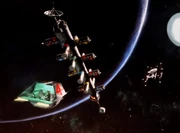
Concept art for "In Thy Image"
Work on developing installments of Phase II began. Alan Dean Foster noted, " A number of writers were called in to submit treatments for hour-long episodes. " ( The Fifty-Year Mission: The First 25 Years , p. 321)
The Lost Series (p.235) states " With an initial order for a two-hour pilot and thirteen episodes, Phase II quickly earned a reputation as one of the toughest shows to sell in Hollywood. Unlike most other series starting their first season, Phase II had the added complication of being a continuation of an earlier series, of which seventy-nine stories had already been told – 101 including the animated episodes. "
As story editor, Jon Povill " had the responsibility of listening to literally hundreds of pitches from a stream of writers, to select those stories he felt were worthy of being considered by the producers. " ( Star Trek Phase II: The Lost Series , p. 235) Story work on potential episodes continued even after it was announced that the series would be aborted in favor of a theatrically released feature film. " As I was under contract as story editor, I continued working with writers and bringing in commissioned scripts until my contract ran out, " said Povill, " even though we were told that they were going to feature sometime in the middle of my story-editor tenure. " ( The Fifty-Year Mission: The First 25 Years , pp. 331-332) Two of the first thirteen stories were rewritten to appear as episodes of The Next Generation – becoming " The Child " (by Jaron Summers & Jon Povill, and Maurice Hurley ) and " Devil's Due " (by Philip LaZebnik , story by Philip LaZebnik and William Douglas Lansford ) in the second and fourth seasons of TNG, respectively.
"In Thy Image" [ ]
This script , written by Harold Livingston , from a story by Alan Dean Foster, ultimately evolved into Star Trek: The Motion Picture .
"Tomorrow and the Stars" [ ]
Written by Larry Alexander , "Tomorrow and the Stars" was a time-travel story that was reminiscent of " The City on the Edge of Forever ", with Kirk falling in love with a woman on Earth at the time of the attack on Pearl Harbor. However, this time, Kirk's passion was for a married woman, giving the romantic angle of the story a slightly edgier approach. At the start of the tale, the Enterprise returned to Earth after a devastating Klingon attack. When Kirk beamed down to Earth, a transporter malfunction turned him essentially see-through and transported him back in time to Pearl Harbor. There, Kirk faced a similar dilemma of knowing he must not take action to save the lives of thousands of people – including the woman he loved – or he would forever alter history.
The writing of the script for "Tomorrow and the Stars" began when Gene Roddenberry gave Larry Alexander a copy of "The Apartment", an undeveloped story Roddenberry had written for the aborted TV series Genesis II . It was Roddenberry's idea that Kirk would travel back to Earth's past; Roddenberry also selected Pearl Harbor as the time and place. " It seemed a very obvious choice, " Alexander observed. He was pleased, though, that setting the episode in Pearl Harbor would allow for the inclusion of footage from various relevant war films. On the other hand, Alexander was disappointed that the setting of the story allowed for very little historical irony in the script. He therefore didn't want the responsibility of writing it. ( Captains' Logs: The Unauthorized Complete Trek Voyages , p. 101)
An unrevised final draft of "Tomorrow and the Stars" was issued on 18 January 1978 . In that script, Kirk responded to the transporter malfunction by crying out, " Xon! What have you done with me?? " That line was an attempt to allude to Kirk's bitterness that Xon wasn't Spock. Larry Alexander felt similar resentment over the fact that he wasn't able to write for Spock in the script, although he did consider Xon to be a Spock substitute "from a character point-of-view." Given his irritation with not being allowed to write for Spock himself, Alexander thought devising the line "seemed the 'logical' thing to do." ( Captains' Logs: The Unauthorized Complete Trek Voyages , p. 101)
"The Child" [ ]
"The Child" was written by Jaron Summers and Jon Povill. In the story, Lieutenant Ilia was mysteriously impregnated, and, within days, gave birth to a baby girl, Irska, who appeared to be fully Deltan. A curious alien lifeform wished to study the crew, but her presence threatened the ship.
This plot was likely based on "Infection", one of multiple suggested story ideas proffered by Gene Roddenberry in his 1964 series proposal " Star Trek is... ". Jon Povill recalled, " In one of the [series' story] meetings, a writer named Jaron Summers pitched a story about space eggs that we were going to reject, but I suggested it could be reworked. Jaron agreed to have me work on it with him; and from that came our draft of 'The Child'. " ( Star Trek Phase II: The Lost Series , pp. 2-3) Povill was tasked with writing "The Child" in one week, as a condition of becoming story editor on Phase II . " I had Jaron Summers do a first draft and then I had to do a pretty complete rewrite, " Povill recalled. " It had to get into shape for shooting, and the way that script came out would determine whether or not I could be the story editor. " The teleplay Povill wrote was sufficiently satisfactory that he got the job. ( Captains' Logs: The Unauthorized Complete Trek Voyages , p. 100) An unrevised final draft script of "The Child" was issued on 9 January 1978 .
When this premise was ultimately used for TNG : " The Child ", Ilia's role was allocated to Deanna Troi . Remarked Jon Povill, " Perhaps this is just writer's ego, but I believe the version of 'The Child' that Jaron and I wrote is far superior to the one that ultimately emerged on Star Trek: The Next Generation." ( Star Trek Phase II: The Lost Series , p. 3) The original Phase II version of the story has been produced as an episode of the Phase II fan-film series , with Povill himself directing.
"Cassandra" [ ]
Written by Theodore Sturgeon , "Cassandra" was about a clumsy yeoman and a tiny, trouble-causing creature, intended to have joined the ranks among such comedy episodes as " The Trouble with Tribbles " and " A Piece of the Action ".
"Kitumba" [ ]
Written by John Meredyth Lucas , this two-part episode provided a glimpse at an alternate Klingon Empire , a culture that had never been examined in detail in The Original Series . The "Kitumba" two-parter featured a complex plot, cloak-and-dagger action, and political maneuverings. Although the Klingon culture later developed along substantially different lines in The Next Generation , the "Kitumba" scripts contained many of the elements that later showed up in TNG episodes involving Klingon and Romulan politics. Like "The Child", "Kitumba" was made into an episode of the Phase II fan-film series .
"Practice in Waking" [ ]
Written by Richard Bach , "Practice in Waking" anticipated The Next Generation 's penchant for placing stories in virtual-reality recreations of historical settings, though here the mechanism was directed dreaming, and not the holodeck .
In this tale, the Enterprise found a sleeper ship with only one passenger; upon beaming over to investigate, Decker, Scotty and Sulu discovered a woman in suspended animation. Scotty inadvertently touched a control panel and the three officers collapsed to the deck, only to reawaken in ancient Scotland without any memory of their lives aboard the starship. They met the same woman and protected her from mobs who accused her of being a witch. On the Enterprise , McCoy determined that the landing party's life signs were becoming progressively weaker. His prognosis was that the longer the trio remained in their dreaming state, the closer they came to dying, so Kirk and his crew had to somehow awaken them before they drifted off into final sleep.
The staff of Phase II expected this narrative would be extremely well received, owing to the fact that Richard Bach had written a couple of best-selling novels in the 1970s. Harold Livingston, for example, noted at the time, " His story should make one hell of an episode. " "Practice in Waking" never made it to script form, but was one of the most popular story ideas among the Phase II staff. ( Captains' Logs: The Unauthorized Complete Trek Voyages , p. 100) Jon Povill enthused, " Richard Bach's 'Practice in Waking' surely would have been a classic. " ( Star Trek Phase II: The Lost Series , p. 3)
"Deadlock" [ ]
Written by David Ambrose , "Deadlock" (which had the working title "All Done with Mirrors") built a portrait of a Starfleet gone mad – practicing mind-control techniques on its personnel, lying to them, and experimenting upon them by altering their perceptions of reality. However, there was another explanation for what Kirk and his crew experienced, leading to a scene in which Kirk defended Humanity to a group of aliens.
An earlier story treatment that was written by David Ambrose and was called "All Done with Mirrors" had the same story as "Deadlock" but a different conclusion. Instead of Starfleet personnel turning out to actually be the aliens in disguise, that early version of the story featured faux Starfleet officers who were part of an underground organization of "dedicated fanatics" who wanted to overthrow the Federation and had pledged to sacrifice their own lives for the cause. ( Captains' Logs: The Unauthorized Complete Trek Voyages , p. 102)
Harold Livingston expected "Deadlock" would be "an extremely exciting story." ( Captains' Logs: The Unauthorized Complete Trek Voyages , p. 102) An unrevised final draft script of "Deadlock" was dated 20 January 1978 .
"The Savage Syndrome" [ ]
Written by Margaret Armen and Alfred Harris , "The Savage Syndrome" featured a technology that unleashed dark urges repressed in Humans. Originally, Armen and Harris pitched the story to Gene Roddenberry, who approved of it because, in Armen's words, "he was looking for something different." ( Captains' Logs: The Unauthorized Complete Trek Voyages , p. 100) An unrevised final draft script of "The Savage Syndrome" was issued on 27 December 1977 .
"Are Unheard Melodies Sweet?" [ ]
Written by Worley Thorne , "Are Unheard Melodies Sweet?" ( aka "Home" and "Id's Delight") called for nudity and suggestive situations that probably would not have been filmed, let alone allowed to air. Yet, the story was a standard Star Trek adventure, with the Enterprise once again being trapped in a failing orbit without dilithium , while an alien race attempted to capture the crew. By the time of The Next Generation , damaged or missing dilithium was recognized as an overused plot element, and the bible for that series specifically stated that the new Enterprise 's dilithium could easily be replaced. Regarding "Are Unheard Melodies Sweet?", Thorne noted, " This was an opportunity to do something I had always wanted to do, " referring to a long-held desire to work on Star Trek . ( Captains' Logs: The Unauthorized Complete Trek Voyages , p. 103)
"Devil's Due" [ ]
In its Phase II format, "Devil's Due" was written by William Douglas Lansford. In the story, the Enterprise made first contact with the planet Neuterra, just as a mythical creature, who had sold the planet in exchange for peace millennia earlier, appeared. In Jon Povill's opinion, this story could " work very well. It had all the elements necessary for a very exciting, involving episode. " Harold Livingston likened the plot to "The Devil and Daniel Webster", then went on to say, " The story has been developed to a point where we all feel it will be a most exciting Star Trek." ( Captains' Logs: The Unauthorized Complete Trek Voyages , p. 102) The original script of "Devil's Due" was issued in 1978.
"Lord Bobby's Obsession" [ ]
"Lord Bobby's Obsession" was written by Shimon Wincelberg . In the narrative, the Enterprise came across a derelict Klingon cruiser with one lifeform aboard: one Lord Bobby from Earth's 18th century . A step outline of "Lord Bobby's Obsession" was written, a revised draft of which was issued on 4 November 1977 .
"To Attain the All" [ ]
"To Attain the All" was written by Norman Spinrad . In the story, the Enterprise became caught in a solar system-sized logic game where the prize was attaining "the All," a huge repository of knowledge. Spinrad commented, " It was about the crew of the Enterprise somehow becoming a hive mind, due to contact with some alien presence. " ( The Star Trek Interview Book , p. 144) Elements from this story are similar to such episodes as TNG : " The Last Outpost " and " Contagion ". Another similar story is TOS : " Return to Tomorrow ", as "To Attain the All" also involved the Enterprise crew discovering a race of disembodied aliens who had highly powerful mental powers but who tried to occupy the bodies of the crew.
"The War to End All Wars" [ ]
Written by Arthur Bernard Lewis , "The War to End All Wars" was derived from a discarded script treatment about warring androids on the planet Shadir ("A War to End Wars" by Richard Bach ). In the story, Kirk rescued a female android, Yra, whose planet's successful philosophy of "peace through war" had been corrupted by a humanoid leader named Plateous III.
Non-commissioned episodes [ ]
There were several episodes that were devised for Star Trek: Phase II but were neither commissioned nor produced. For instance, Margaret Armen and Alf Harris pitched three stories to Gene Roddenberry, despite only "The Savage Syndrome" ultimately being selected. ( Captains' Logs: The Unauthorized Complete Trek Voyages , p. 100) Likewise, prior to working on "In Thy Image", Alan Dean Foster pitched three story concepts, neither of which was accepted for the series. ( The Fifty-Year Mission: The First 25 Years , p. 321)
"Ghost Story" [ ]
"Ghost Story" was a story outline by Larry Alexander. [5] The plot was a precursor of "Tomorrow and the Stars" (also by Alexander) and was heavily influenced by the science fiction film Forbidden Planet .
In "Ghost Story", Kirk and a landing party arrived on a planet lying in ruins. They discovered highly advanced technology on the planet, but no sign of a living civilization. Kirk entered a science lab and was projected backwards in time. In the past, he encountered a pair of scientists who had developed a machine to scan the mind, though it operated quite differently on a Human. Hooked up to Kirk's mind, the device caused him extreme agony. Demons from within his mind, the Id, materialized and destroyed all life on the planet, resulting in the destruction witnessed at the beginning of the tale.
Larry Alexander was careful to point out, in the course of the narrative, that Kirk wasn't technically responsible for the planet's destruction. " He asked them not to do it. I was very strict about that, " the writer clarified. " He didn't volunteer to do this, and when he realized what was going on, he did everything possible to stop it. All of that, I think, holds up on that basis. I was thinking very strictly about what happened to Kirk in many episodes where things didn't turn out the way he hoped. " One such example was Kirk's inability to prevent the death of Edith Keeler at the end of " The City on the Edge of Forever ". " It's like that when the people of this planet find that it's his demons which have destroyed their world, not theirs, " the writer added. " It makes it that much more ironic. "
Indeed, Larry Alexander was very proud of "Ghost Story", commenting, " I thought it was a wonderful story idea to have Captain Kirk responsible for the death of a planet, and it's the one step beyond Forbidden Planet that had never been dealt with. It makes it much more Human and, to me, much more of an interesting irony. That's the kind of material I think is interesting and I was shocked when Gene Roddenberry said he didn't want to go with it. " Whereas Roddenberry opted for Alexander to instead write "Tomorrow and the Stars", Alexander was more appreciative of the irony in "Ghost Story" than what little irony could be written into a tale about Kirk going back in time to Pearl Harbor. ( Captains' Logs: The Unauthorized Complete Trek Voyages , p. 101)
"Merlin's Magic" [ ]
"Merlin's Magic" was a story outline by Steve Kelly . [6]
"Paradise Lost" [ ]
"Paradise Lost" was a story outline by Arthur Heinemann. [7]
"The Prisoner" [ ]
"The Prisoner" was a story treatment written by James Menzies . [8] In the story, Albert Einstein suddenly appeared on the Enterprise 's main viewscreen, startling the bridge officers. He appealed for their help, and explained that he and many other scientists from Earth had been abducted and kept alive by a "storage battery" on an alien planet. Kirk was skeptical that he was talking with the real Einstein, but his curiosity was piqued, so he ordered the Enterprise to the planet where, purportedly, Einstein was. While the ship orbited that world, six scientists from Earth's past (circa the 20th century) appeared in the transporter room. Xon quickly discerned that they were not actually living beings, but rather highly realistic illusions.
Realizing the trap they had been caught in, Kirk ordered the Enterprise to break orbit, though that turned out to be impossible. He himself then beamed down to the planet's surface, where he encountered Logos, an alien who was the culprit behind the charade. His goal was to assume all Human life, starting with Kirk and his crew. Logos felt this was only fair, given the extreme savageness of the Human race, constantly living under the threat of nuclear annihilation. Kirk argued that the Earth which Logos spoke of was ancient history, but the alien refused to accept that, insisting that man would never change. A battle of wills ensued between Logos and the Enterprise crew, with the future of Humanity at stake. ( Captains' Logs: The Unauthorized Complete Trek Voyages , p. 101)
Characters [ ]
The original cast returned to reprise their roles (with the notable exception of Leonard Nimoy ), alongside several new characters: Xon (replacing Spock as science officer), navigator Ilia , and first officer Willard "Will" Decker .
James T. Kirk [ ]
William Shatner returned to Star Trek to reprise the role of Captain James T. Kirk . The writers/directors guide, written, among others, by Gene Roddenberry and Jon Povill between May and August 1977, described Kirk as follows:
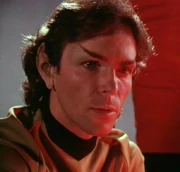
Phase II image of David Gautreaux as Xon
Leonard Nimoy was offered a role as Spock in only two of the projected thirteen episodes, an offer that he thought was insulting to both himself and the character of Spock. Once he had declined this offer, a new actor, David Gautreaux , was cast to fulfill the role of the Vulcan science officer aboard the Enterprise . Xon, however, did not make it into the final script of The Motion Picture due to Nimoy's return in the role of Spock . The actor made a cameo appearance as Commander Branch of Epsilon IX station .
Elements of the character of Xon, such as his search to understand Humans, were transferred later into TNG 's character of Data . Also, the concept of a full-blooded Vulcan having to deal with "barbaric" Humans was explored with T'Pol aboard Enterprise NX-01 .
The writers/directors guide, written, among others, by Gene Roddenberry and Jon Povill between May and August 1977, described Xon as followed:
Will Decker [ ]
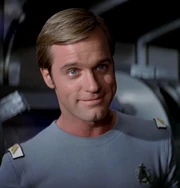
Decker ( Stephen Collins ) as he appeared in Star Trek: The Motion Picture
Willard "Will" Decker was another of the new characters among the cast, supposed to fulfill the role of ship's first officer . The role had not been cast at the time of the series shutdown; Stephen Collins played the character in The Motion Picture . Much of what had been laid down for the character of Decker formed the basis for First Officer William "Will" Riker of The Next Generation , as is apparent from how the character is described in the writers/directors guide, written, among others, by Gene Roddenberry and Jon Povill between May and August 1977.
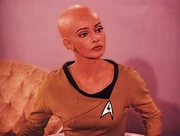
Phase II publicity photo of Persis Khambatta as Ilia
The third new character to Star Trek came in the form of Lieutenant Ilia (pronounced "Il-ee-ah"), performed by Persis Khambatta . Gene Roddenberry's and Jon Povill's 1977 writers/directors guide described her as:
Certain characteristics of Lieutenant Ilia, such as her relationship to the young first officer and empathic abilities later formed the basis for the character of Counselor Deanna Troi of The Next Generation .
Leonard McCoy [ ]
DeForest Kelley was to reprise his role of Dr. Leonard McCoy on Phase II . Gene Roddenberry's and Jon Povill's 1977 writers/directors guide described him as:
Montgomery Scott [ ]
James Doohan was to reprise his role of Chief Engineer Montgomery Scott on Phase II . Gene Roddenberry's and Jon Povill's 1977 writers/directors guide described him as having:
Walter Koenig was to reprise his role of Pavel Chekov on Phase II . Gene Roddenberry's and Jon Povill's 1977 writers/directors guide described him as follows:
Christine Chapel [ ]
Majel Barrett was to reprise her role of Christine Chapel on Phase II . Originally a nurse on the original Star Trek , she returned as a full doctor to serve as McCoy's associate. Gene Roddenberry's and Jon Povill's 1977 writers/directors guide described her as being:
Phase II would have featured Rand herself in "In Thy Image", and a Yeoman Jennifer York – an exo-linguist – in "Lord Bobby's Obsession", with the rank of yeoman also to have been mentioned in "Kitumba, Part I".
Merchandise gallery [ ]
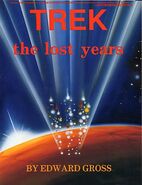
Credits [ ]
Aside from the cast, a production staff end credit roll was already foreseen and was, tentatively, projected to read as follows ( Star Trek Phase II: The Lost Series , pp. 354-355):
Production staff [ ]
Uncredited production staff [ ].
Extensive though this might have seen, there were more than enough production staffers that went without credit, including,
- Gregory Jein – Magicam, Inc .: Model Maker
- Don Loos – Brick Price Movie Miniatures : Model Maker
- William Norton – Director of Photography: Screen Tests
- Brick Price – Brick Price Movie Miniatures: Supervising Model Maker
- Jim Rugg – Special Effects
- Mark Tanz – Special Effects
Uncredited production companies [ ]
- Brick Price Movie Miniatures – Sub-contracted/Models, miniatures and props
Further reading [ ]
- The Making of Star Trek: The Motion Picture , March 1980 – Chapter 4: "The Almost (Again) Television Show"
- Trek: The Lost Years , December 1987
- Lost Voyages of Trek and The Next Generation , August 1992
- The Art of Star Trek , November 1995
- Star Trek: Phase II - The Making of the Lost Series , March 1997
- Star Trek Monthly issue 26 , pp. 30-32
- Star Trek: Waypoint, Issue 6 : " The Fear "
- Bonus issue 8, January 2018
- Bonus issue 19, October 2019
Special features [ ]
- Phase II: The Lost Enterprise ( Star Trek: The Motion Picture (The Director's Edition) DVD , disc 2, 2001)
- Star Trek: The Journey to the Silver Screen – Chapter 1: "The New Frontier: Resurrecting Star Trek" ( Star Trek 50th Anniversary TV and Movie Collection Blu-ray set, bonus disc, 2016)
External link [ ]
- Phase II at Forgotten Trek
- Star Trek: Phase II at Wikipedia
- 1 Daniels (Crewman)
- 3 Calypso (episode)
Fan Film Factor
Exploring the world of Star Trek fan films.

A history of STAR TREK CONTINUES (feature, part 1)
NOTE: About a year a half ago, I published a 3-part blog tracing the fascinating history of STAR TREK CONTINUES . In honor of their penultimate episode being released this past week and their series finale next month, I will be reprinting these blogs and adding an additional blog or two covering what happened between then and now.
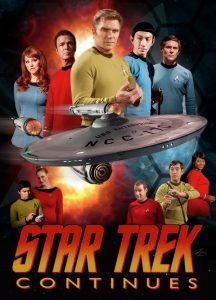
Those were the last two words uttered by Captain Kirk before Star Trek the original series was canceled in 1969.
Kirk was referring to the tragic descent into hate-filled insanity of his former love, Dr. Janice Lester. But for me, these two words were so much more powerful: If only Star Trek hadn’t been canceled. If only Star Tre k could have…
…continued.
TOS fans always felt a pang of frustration that the five -year mission of the USS Enterprise was cut short after only three years in space (and on the air). Sure, in 1973 an 1974, we got to see 22 animated episodes of the series, voiced by the same original actors, but we never got to see the end of that five-year mission.
Even when Star Trek crossed over into motion pictures, the end of Kirk’s first mission was still a mystery. And the days of seeing those those bright red, blue, and gold uniforms and those amazingly colorful starship Enterprise sets—those days were gone forever…except in reruns, of course.
I used to have this dream where I was watching an episode of TOS that I’d never seen before. Of course, I’d seen every episode dozens of times, so when I woke up, I’d sadly remember that there were no “lost” episodes of TOS.
Until there were…
I first felt that “feeling” that I was watching a “lost” episode in 2013 when I saw the first full-length episode of the new fan series STAR TREK CONTINUES …an episode titled “ Pilgrim of Eternity . ”
I’ll be honest, though, I didn’t feel it immediately. It hit me at about the 31-minute mark of the episode. Before that, this Star Trek Continues seemed fairly similar to Star Trek: New Voyages/Phase II , the trailblazing fan series from JAMES CAWLEY, who was the first to ever spend six-figures building precise recreations of the TOS sets from the 1960s. Both fan series were telling “untold” stories from the fourth and fifth years of Kirk’s five-year mission. In fact, VIC MIGNGNA, the show-runner behind Star Trek Continues , actually got his start in Trek fan films directing and guest-starring in one of Phase II ‘s most ambitious productions, an episode called “ Kitumba .”

The most notable difference between the two productions—aside from the actors—was that NV/P2 decided to film in a widescreen 16×9 aspect ratio format, giving their series a more modern look. And their VFX shots of the Enterprise included new angles and movements not previously seen in the original series. STC , meanwhile, opted for a more classic 4×3 aspect format, intending for their episodes to feel almost exactly like the original series. To that end, they also kept their VFX angles of the Enterprise similar to those seen in the 1960s episodes.
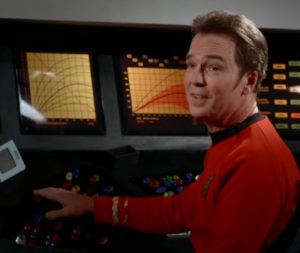
The other notable difference between the two series, and one of the things that most excited fans like me, was that CHRIS DOOHAN, the son of TOS actor JAMES “Scotty” DOOHAN, would be reprising his father’s role (and Scottish brogue). Although NV/P2 had featured a wide range of TOS and sci-fi actors as special guest stars (including Walter Koenig, George Takei, Grace Lee Whitney, and Denise Crosby), they would appear in single episodes rather than being a part of the regular cast.
None of this is meant to diminish the spectacular accomplishments of New Voyages/Phase 2 . By the time that Star Trek Continues premiered their first full episode in May of 2013, NV/P2 had already released EIGHT full-length episodes, with even more in production! So in many ways, STC was standing on the shoulders of a giant.
Anyway, there I was in 2013, watching this brand new fan series and thinking it was pretty impressive…much like NV/P2 . It looked fantastic—nicely lit, well-fitting costumes, good hair and make-up, decent acting, and of course, amazing sets. But it still felt like a fan film. That’s not to say it was bad. It was excellent! But fan films usually don’t reach the threshold of looking or feeling like the real thing. Even at its best, NV/P2 didn’t make me feel as though I were watching an actual “lost” episode. And for the first half hour, “Pilgrim of Eternity” didn’t really give me that feeling either…and to be honest, I wasn’t really expecting it to.
But then it happened.
The moment lasted only about a minute and a half, but there it was: that feeling ! It was the same feeling I’d had as a kid watching a TOS episode for the first time! It was, quite literally, the feeling I’d been dreaming about for decades.
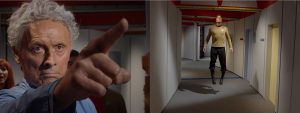
At the midway point of the episode, where the god Apollo suddenly strengthens and turns his powers on Kirk, in that moment I suddenly forgot I was watching a “fan” film and immersed myself in the belief that I was watching a never-before-discovered episode of the original Star Trek !
Of course, I knew in my head that the actors were different (except for Apollo). But in that moment when I heard Apollo’s voice reverberate, saw Kirk tossed into the air like a rag doll, and listened to that familiar music, it didn’t matter that it wasn’t William Shatner hitting the floor and being levitated. In those 90 seconds, in my heart, I was watching “pure” Star Trek .
I was hooked.
Star Trek Continues grew out of the Starship Farragut fan series. In fact, Vic Mignogna first played a cameo role of Captain James T. Kirk in the third full-length episode of the Farragut series, “The Price of Anything” which Vic also directed. (Look for Vic starting at the 1 minute, 45 second mark.)
Vic put in both his own money and secured financial backing from Dracogen Strategic Investments in late 2011, allowing Farragut Films to move into a much larger studio in Kingsland, GA. This additional studio space and influx of capital gave Farragut Films the opportunity to expand their sets to include nearly every USS Enterprise interior that existed at Desilu studios back in the 1960s (except Engineering).
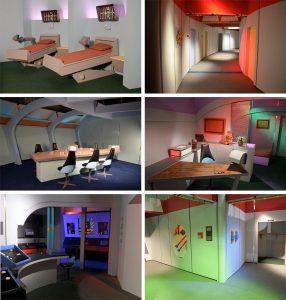
It was obvious almost from the beginning that the acting was of a higher caliber than that of many other fan productions. Not to put down other fan films, but Vic Mignogna, himself a well-known voice-over actor, insisted on bringing in others with acting backgrounds…and it showed. These weren’t Emmy-winning Hollywood celebrities, of course, but they were more polished and professional than the typical amateur fans who populated most fan films.
But it didn’t stop there. Vic will be among the first to tell people who enjoy STC that the series owes its success to a lot more people than just him and the folks in front of the camera. STC is composed of a dedicated team (made up of both fans and industry veterans) who do professional-level work out of a love for this legendary franchise. I could spend several blogs just talking about the many individuals who make STC possible, but I want to shine a special light (pun intended) on Director of Photography Matt Bucy…to give you an idea of why it is that STC looks so close to the original Star Trek series.
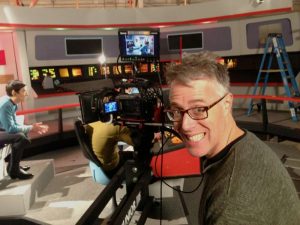
A resident of Vermont, this self-taught cinematographer had to fly down to Kingsland, GA for each episode to work his magic on STC (Matt is also a recreational pilot, but I suspect he flew commercial to get to Georgia). And part of that magic was lighting the STC sets the EXACT same way that the original sets were lit. You might be thinking, “Oh, that sounds so easy!” You’d be wrong.
Working closely with Vic, Matt carefully examined more than three thousand still images from multiple TOS season two and three episodes, trying to figure out precisely how the scenes and characters were lit. In an interview on the STC website, Matt commented, “One trick that directors of photography use is to look at the eyeballs of the actors. If you study them carefully, you can see a big dot that is reflecting the key light. You can see how a light will pick up the hair and shoulders.”
But it wasn’t as simple as just looking at eye reflections. Lighting on sets creates shadow and depth, can add color, and even provide texture on areas that would otherwise look flat if lit incorrectly. Matt continued, “It’s basically stage lighting, using hard light – a key light, a fill light, and a backlight. So we’re using a lot of light sources. When you look at the 1960’s series with a critical eye on lighting, you’ll notice that they didn’t care much about multiple shadows. In fact, I think that’s one of the things that makes our production feel so similar – because there are shadows everywhere! Light is coming from above, usually at a 45-degree angle with the actors. And there are certain facial shadows that give Star Trek Continues a very ‘classic Trek ’ look.”
Of course, the lights need something to actually illuminate, and in that department, Matt Bucy was also instrumental. In addition to being a pilot, Matt is also an architect and electronics wiz. (He’s also a real estate developer, if you’re curious.) But when it came to architecture, his expertise allowed the construction team to recreate the exact layout of the original Trek sets as they fit together on Stage 9 at Desilu Studios back in the 1960s. Take a look at this amazing walk-through of their sets:
Goose bumps, right?
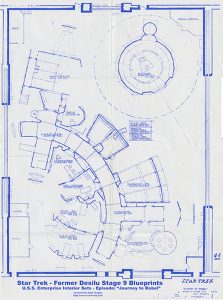
Indeed! In the meantime, other “little touches” abound in Star Trek Continues , some easier to notice than others. For example, it’s pretty obvious that the earliest STC episodes used much of the music and sound effects in the original Star Trek . But what you probably won’t notice unless you look closely is that the blocking of the actors (where they stand in a scene) is purposefully done to mimic what was done 50 years ago, as is the acting style. It’s not just that the actors are doing impressions of Shatner, Nimoy, Kelley, and the rest. They are working very hard to move their bodies, manipulate their facial expressions, and control their vocal delivery to mirror the performances provided back in the 1960s. Modern acting styles can present very different performances that, while still strong and engaging, would not have the same feel as TOS. Likewise are many directing choices, such as cutting to close-up reaction shots with a flourish of incidental music or showing a subtle sideways glance of one character to another.
And if that isn’t enough to impress you, there’s two final touches that are added in post-production. First, the colors in each scene are super-saturated to have that over-colorful look of the original Star Trek . And second, because Trek was originally filmed on 35mm film and not video, STC digitally adds in a “graininess” during post-production to make the image look a little less “perfect”…and that, my friends, is what makes it come out so perfect!
Next time : our focus on Star Trek Continues …er…continues with more about the actors and the earliest vignettes released to introduce this new fan series. We also begin spotlighting the episodes themselves with a closer look at “Pilgrim of Eternity” and how that production came together. And finally, we learn how much of his own money Vic Mignogna put into the roll out of STC and what happened when they held their first Kickstarter…er, KIRKstarter!
All of the amazing offerings of STC can be found on their website:
http://startrekcontinues.com/episodes.html
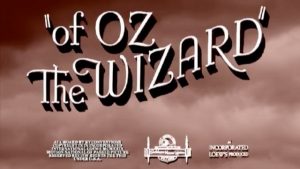
I can’t really describe it, and I’ve only made it through about 54 minutes so far (I’m up to “look”), but I guarantee you’ll want to share it on Facebook! I cannot imagine the amount of work that went into editing this video!
Share this:
- Click to email a link to a friend (Opens in new window)
- Click to print (Opens in new window)
- Click to share on Facebook (Opens in new window)
- Click to share on Twitter (Opens in new window)
- Click to share on Tumblr (Opens in new window)
- Click to share on Reddit (Opens in new window)
13 thoughts on “A history of STAR TREK CONTINUES (feature, part 1)”
I always wondered how the Theatrical acting quality of the cast of Babylon 5 was “missing” something that Star Trek had.. and I think you’ve found the head of the nail.
Its not that Trek was Scientifically “accurate” or “engaging”.. at the time most of it was speculative and fantastical.. as much as it was Science Fiction.. it was very emotionally charged.
But Trek seemed to roll around in all kinds of recent scientific speculation in service to the story. It was a kind of romper room for young adults or people coming of age, introducing them to all sorts of controversial ideas the conservative grown ups viewed with suspicion… it was a kind of counter culture.
But the sets the lighting, it was all theatrical make up.. just good enough to set the stage for a play, garnished with flourishes of cutting edge Special Effects.
When Star Trek the Movie and all that came after it were pumping money into Star Trek to make it seem “more real” they were taking away, or re-casting the story in a different mold that was not very much Original Trek.. it lacked the setting.. it was something different.
By virture of its limited budget Wrath of Kahn was “closer” to the original because of that limited budget, limited sets, use of physical mixed with digital Matte paintings for backdrops. It looked corny sure.. but in the World of Real Trek.. it was acceptable, okay.. even better than scientifically accurate Apollo Era detailed spacecraft like V’ger.. which was so 70’s.
Next Generation was similarly “handicapped” with a limited budget for new set construction, but a higher budget for special fx.. until later in its seasonal run.. in which the stories got better and better because of the lack of resources.. less was more.. the Writers Strike was the best thing ever to happen to them.. withholding the story until the next season opener.. brilliant!
Its so wickely odd.. but I think something very important has been stumbled upon here.. Star Trek is at its best when it leaves more to the Imagination.. when it has a tighter budget… when its a limited run.
Lucy.. I think for the greater good.. you’d best not Have anymore ‘Explaining to do.. leave it alone.
I think you hit on some interesting points there, John. Maybe Star Trek was at its best when the lower budgets forced the stories and acting to “sell” the episode or movie. When you rely too much on fancy VFX, funky costumes and make-up, and elaborately lit sets—when you take away the actors’ ability to actually act by covering their face in unwieldy prosthetics and sticking marbles into their mouths (and making them speak four pages of dialog in a language they never heard before being cast)–when you do all of that, the story itself has the potential to suffer by getting lost in all of the noise and chaos.
Oh, and what’s this I hear about Babylon 5 missing something? That show had half the budget of Star Trek, dude.
I really didn’t know that about Babylon 5.. those VideoToasters really did great for the time. And isn’t it the same company Will Wheaton went to work for after Next Generation?
One thing though that rarely gets paid attention to though is the terrific theatrical scene music.. I’m not speaking of the rip roaring themes.. but the Vulcan tone poems, those striking Crescendos just before Kirk makes a decision or right after. Bones raised eyebrow and the serious or playful little melody. — if those weren’t “over the top” I don’t know what was.. B5 had them too.. but not as strong.
I really love how STC reused those familar vibes.. perfectly placing them.. it made my childhood come back in Vivid color. .. Gosh darn it.. I want another episode !
Wil Wheaton ended up working for NewTek, the makers of the Amiga-based Video Toaster that was used to create the CGI effects for Babylon 5. (Newtek was based in Topeka, KS back then.)
The folks who actually did the VFX for B5–which was the first weekly TV series to use CGI rather than physical models for all of their outer space shots and also for some of their interiors and aliens–was Foundation Imaging…based in Valencia, CA. (Yep, the same Valencia where Axanar Productions built Industry Studios.) Wil Wheaton never worked for Foundation Imagining.
Foundation went on to do amazing VFX for the first few seasons of B5 and later worked on DS9 and Voyager, winning an Emmy for the latter. My long-time friend and collaborator on Starship Spotter , Adam “Mojo” Lebowitz, worked both at NewTek and Foundation, and later worked with Gary Hutzel and Doug Drexler on Battlestar Galactica, helping them win an Emmy, as well.
I bet you didn’t need to know any of that! 🙂
Very interesting to a kid from way back here in the sticks though.
That all seems to far away.. less real.. than the shows that reached us through the TV.
BSG.. didn’t Jamie Bamber (the new Apollo) appear in one of James Cawley’s New Voyages episodes?
Funny about Wil Wheaton though.. for some reason.. I guess because Colm Meaney and Michael Dorn showed up on DS9.. I always thought Wesley Crusher would show up on Voyager. Little did I know he wanted a clean break for a while.
My early 20 somethings I was thinking ‘Nova chron’ had to be in the Delta Quadrant and Wesley and the Traveler might actually be behind Voyagers winding up there instead of that Cat Paw like invaders from another Galaxy plot device.
Somehow Wesley maturing as an individual that might challenge even the powers of the ‘Q’ seemed rational to me.. after rescuing his Mom from the collapsing Warp Bubble Universe.. what he learned from that encounter spoke to a higher order of manipulating reality… maybe even discovering reality was a kind of program running on an alien super computer.. and unmasking the ‘Q’ as mere aliens that were aware of the true nature of reality. .. it dove tails rather nicely with the fate of Professor Moriarity.. and Picards suspicion.. that [all of this] might merely be a program running on a little device in someone elses living room.
.. I’ve had too many years to think about Next Gen locked in my solitary mind all alone.
Jamie Bamber was in the first episode of Star Trek Continues, “Pilgrim of Eternity.” I discuss the full cast of that fan film more in part 2 and mention Jamie.
As for Wesley, it’s kinda funny you should point that out. Harlan Ellison used to say that Gene Roddenberry had only one idea that he kept writing over and over and over and over again: “The Enterprise meets God, and God is a child.” In Wesley’s case, he started off as a child and kind of became God. Interesting, huh?
The sets on Continues are amazing – It is so impressive how they were able to so accurately portray the look and feel of T.O.S., as well as the portrayal of some of the characters, particularly Kirk, Spock, and even Scotty to some degree… P
Both STC and New Voyages built amazing TOS sets.
“The Enterprise meets God, and God is a child.” In Wesley’s case, he started off as a child and kind of became God. Interesting, huh? ..
Lol.. such is the fate of every Child.. to become their Parents, though as a Child I think we all aspired to that one day.. what little did we know..
Yeah, but I’m not God, John. I don’t even play him on TV. 🙂
Not even with the Big “Booming Voice” ?
Any father sufficiently older is indistingushable from a god or his creator.
Just ask 10 year old Data.
I think Jayden thinks of me as more fun than God…although God does wear a giant chicken costume. (That’s a long story.) 🙂
That’s probably what the Kelvins thought.. Kirk begged to differ however.
Comments are closed.
Star Trek Channel
A continuing journey..

Star Trek: New Voyages / Phase II
Star trek phase 2 – special featurette.
04xV1 – Center Seat
04xV2 – No Win Scenario
04xV3 – 1701 Pennsylvania Av
04xV4 – Going Boldly
4×00 – Come What May
4×01 – In Harm’s Way – Directors Cut
4×02 – To Serve All My Days
4×03 – World Enough and Time
4×04 – Blood and Fire, Part 1 of 2
4×05 – Blood and Fire, Part 2 of 2
4×06 – Enemy Starfleet
4×07 – The Child
4×08 – Kitumba
4×09 – The Holiest Thing – Trailer
Mind Sifter (Preview 1) Episode 4.10: “Mind-Sifter”
Mind Sifter (Preview 2) Episode 4.10: “Mind-Sifter”
“Mind-Sifter” Modern VFX
https://www.youtube.com/watch?v=zFjikVnvypg
“Mind-Sifter” Retro 60s VFX
- Cast & crew
- User reviews

Episode list
Star trek phase ii.

S4.E0 ∙ Come What May

S4.E1 ∙ In Harm's Way

S4.E2 ∙ To Serve All My Days


S4.E3 ∙ World Enough and Time

S4.E4 ∙ Blood and Fire: Part One

S4.E5 ∙ Blood and Fire: Part Two

S4.E6 ∙ Enemy Starfleet

S4.E7 ∙ The Child

S4.E8 ∙ Kitumba

S4.E9 ∙ Mind-Sifter

S4.E10 ∙ The Holiest Thing
S4.e11 ∙ origins: the protracted man.

S4.E12 ∙ Torment of Destiny
Contribute to this page.

- See more gaps
- Learn more about contributing
More from this title
More to explore, recently viewed.

The Making of Star Trek: Phase II
After several attempts to bring Star Trek to the silver screen, Paramount decided in 1977 to produce a second television series, called Phase II .
Barry Diller, Paramount’s president, had been concerned about the direction in which Chris Bryant and Allan Scott were taking the franchise with their script for the proposed movie Planet of the Titans . He turned to Gene Roddenberry and suggested it was time to take Star Trek back to its original context: television.

When Phase II was officially announced on June 10, 1977, fans learned it would become the flagship of a Paramount television network.
The advantage of setting up a network was obvious: the studio was cutting out the middleman.
As a content provider to the networks, Paramount would produce a series, license it to a network, often at a loss, and then watch as the network sold the series to advertisers at a profit. Only when, and if, the series went to syndication would the studio have a chance to earn extra money.
But, in the case of licensing a Paramount-produced series to a Paramount-owned network, one division of the company would be selling to another and all the money would stay in the family.
That offered the possibility that a series could at least break even, without the long wait until syndication. And syndication could be a never-ending stream of income, as Paramount’s “79 jewels” proved year after year.
Those 79 were, of course, the original Star Trek episodes.
Another advantage was that Star Trek attracted television’s most vaunted demographic: men aged 18 to 34.
The plan was for an all-new Star Trek television series to anchor the new Paramount network. Star Trek: Phase II was officially a go. A two-hour made-for-TV movie would lead the way in February 1978, to be followed each week by a brand new, one-hour episode, airing between 8 and 9 at night.
Gathering a team

Gene Roddenberry was ecstatic. After five year of false starts, all the pieces were at last falling into place. It was time to be Star Trek ’s lightning rod again and gather a team.
Roddenberry hired two producers. Robert Goodwin, who was an assistant to Paramount’s head of television production, would be responsible for the technical side of things. For the writing side, Roddenberry hired noted novelist and screenwriter Harold Livingston.
Neither had worked with Roddenberry before. Goodwin was meant to produce made-for-TV movies for Paramount and later said he was “strong-armed” into doing Star Trek . Livingston described himself as “totally unwashed” when it came to Star Trek , but he and Roddenberry hit it off.
We had similar backgrounds. We had both been in the Air Force during the war and we both worked for civilian airlines after the war.
Livingston persuaded Roddenberry to promote his assistant, Jon Povill, to story editor.
“Harold had not been very familiar with the old series at all,” Povill recalled years later, “and kind of relied on me to monitor whether something fit with Star Trek or not.”
A final team member Roddenberry enlisted was an old friend: Matt Jefferies, Star Trek ’s first art director. He was working on Michael Landon’s hit series Little House on the Prairie at the time and was reluctant to give it up for the sake of thirteen new Star Trek episodes. But Roddenberry was adamant. Only Jefferies, he said, could update the Enterprise . With Landon’s blessing, Jefferies joined the Phase II crew as a “technical advisor”.
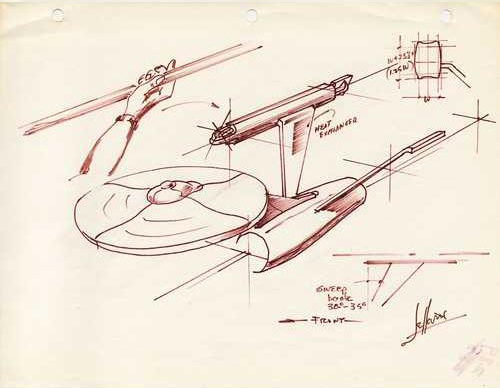
Landon made clear that Jefferies’ work for Star Trek could not get in the way of his responsibilities on Little House . That’s how Jefferies came to recommend his friend Joe Jennings as the new Star Trek art director.
Other Star Trek veterans who joined the crew included Mike Minor in the Art Department and William Ware Theiss as costume designer. Lee Cole joined the graphics team. She would go on to have a big influence on the sets of the first two Star Trek motion pictures.
The bigger challenge was getting the cast back together. William Shatner demanded more money. Leonard Nimoy was unwilling to return at all.
In order to fill the void created by Spock’s absence, three new characters were added — and hopes were that Nimoy might be persuaded to occasionally reprise his role in guest appearances.
Replacing Spock on the bridge would be Lieutenant Xon, a young and bright Vulcan science officer. Unlike Spock, Xon would have virtually no knowledge of the human equation. He would try to imitate humans in order to get closer to the crew. “We’ll get some humor out of Xon trying to simulate laughter, anger, fear and other human feelings,” Roddenberry wrote. (Sound like any androids we know?)
The second new character was Commander Will Decker, son of the Commodore Matt Decker who was killed in “The Doomsday Machine”. Contrary to his antagonist relationship with Kirk in The Motion Picture , the Phase II Decker would greatly admire the captain. The character was created with the possibility that Shatner might eventually become too expensive for the show in mind.
The final addition was Lieutenant Ilia, a bald Deltan, whose race was marked by its heightened sexuality. She would have empathetic abilities and a history with Decker, foreshadowing the character of Counselor Troi.

Povill argued that the new characters helped tremendously in finding new stories to tell:
I think the biggest challenge was coming up with things that weren’t repeats of ideas which had already been explored.
He particularly liked Xon.
I thought there was something very fresh in having a nice young Vulcan to deal with, somebody who was trying to live up to a previous image. That, to me, was a very nice gimmick for a TV show that was missing Spock.
Going boldly
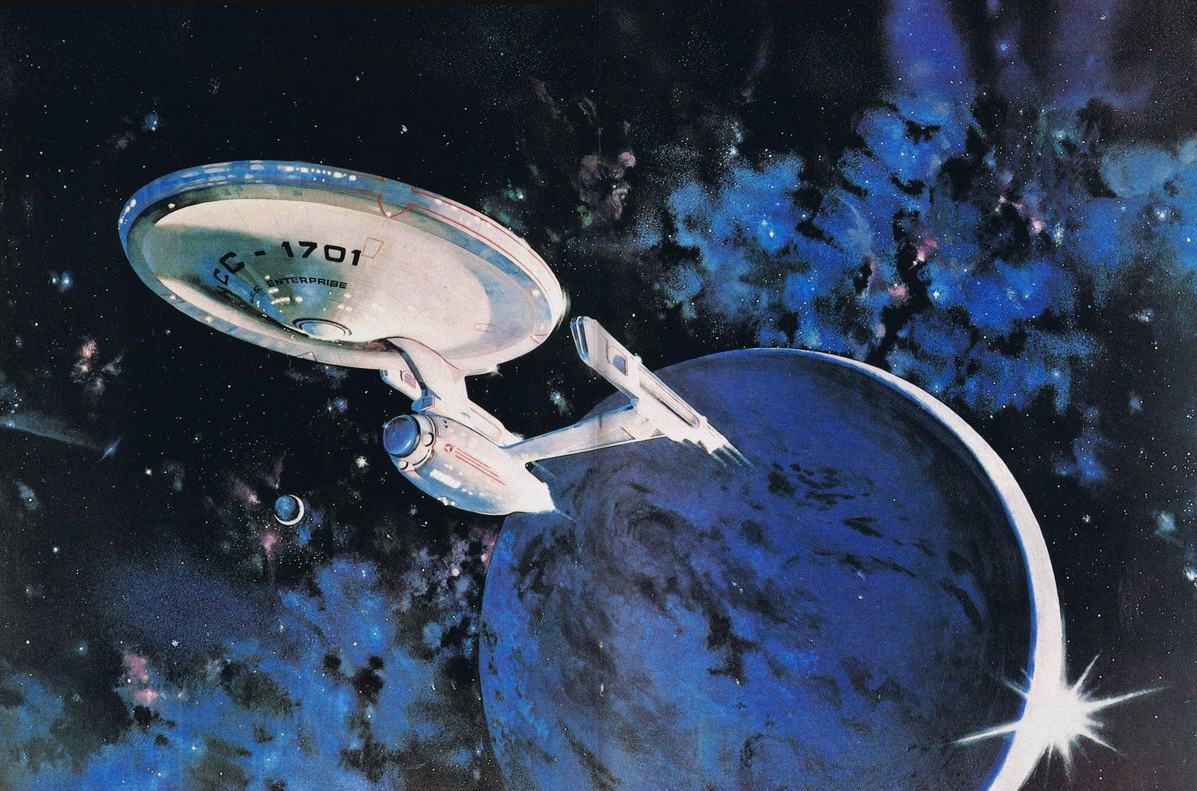
Television had changed a lot since The Original Series aired more than a decade ago. Roddenberry told Starlog magazine in March 1978 that the second series could be bolder than the first:
The audience is certainly more sophisticated and able to reach their minds out further. The audience is ready for statements on sex, religion, politics and so on, which we never would have dared to make before.
In his guide to Star Trek writers, Roddenberry advised:
We will use science fiction to make comments on today, but today is now a dozen years later than the first Star Trek . Humanity faces many new questions and puzzles which were not obvious back in the 1960s, all of them suggesting new stories and themes.
But some things would not change. Star Trek was still a show about people. Science and gadgetry could not distract from the plot. Captain Kirk and his crew were heroes and should always react as such. Their home base was the Enterprise .
A movie after all
Jefferies was upgrading the Enterprise . Sophisticated new aluminum phasers, following the same design as the original wood-and-plastic ones, were being built, some with working strobe lights and detachable battery packs. Sets were going up on Paramount’s Stage 9. Goodwin reported:
All frames and platforms have been built for the bridge… By tomorrow we will have a layout on the stage floor for the corridor and by the beginning of next week we will start framing and constructing the corridor walls.
Livingston had recruited a slew of science-fiction writers: Margaret Armen, Alan Dean Foster, Arthur Heinemann, John Meredyth Lucas, James Menzies, Theodore Sturgeon, Worley Thorne, Shimon Wincelberg. Only Sturgeon ultimately didn’t turn in his story.
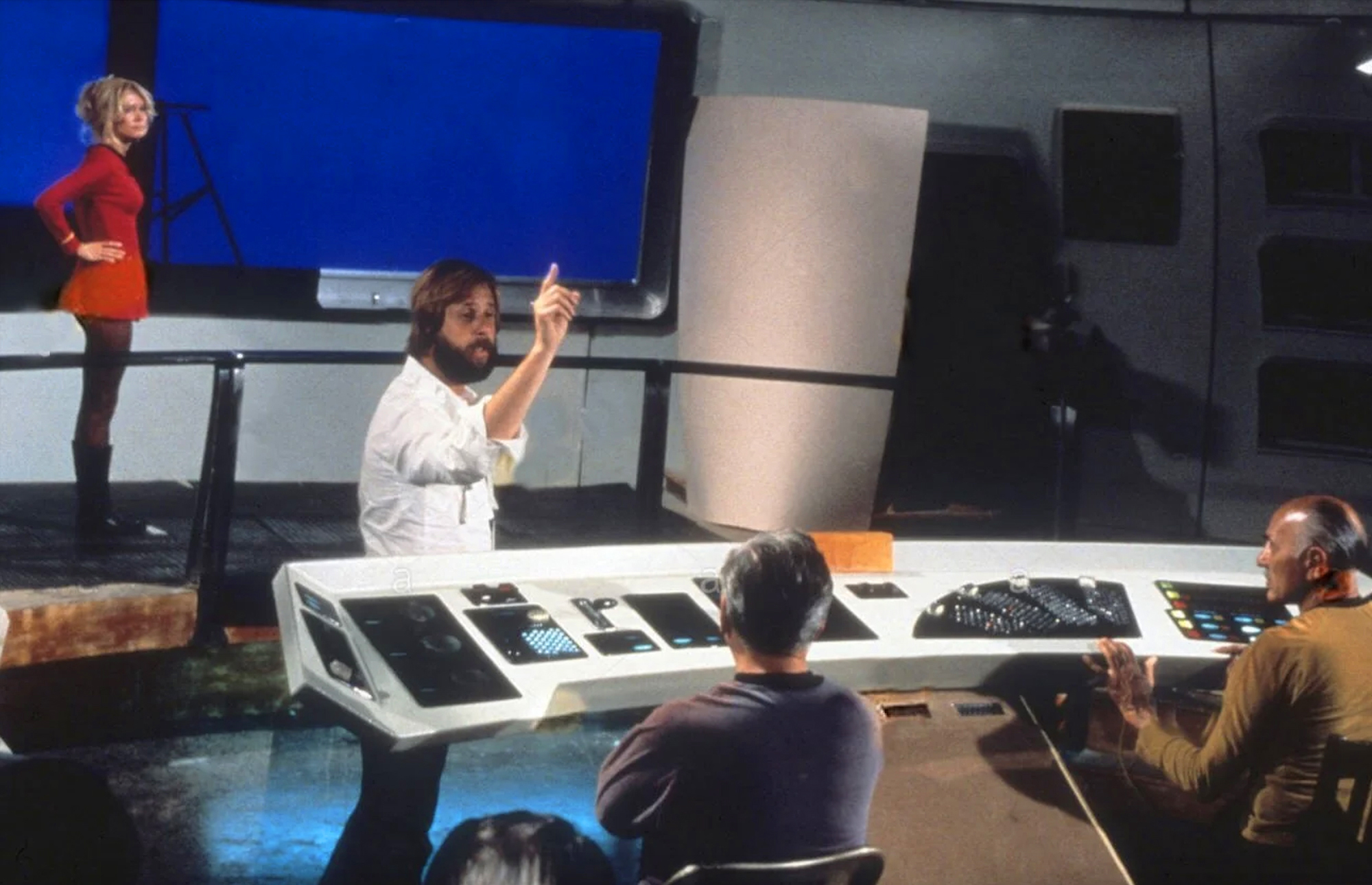
In addition, he was receiving unsolicited pitches and scripts from many more authors. “They keep coming in and the response from writers is totally overwhelming,” Livingston reported in a memo. Most were turned down and Star Trek quickly developed a reputation as the “hardest sell in town”.
Heinemann pitched, and Foster wrote, the show’s pilot, “In Thy Image”. It incorporated Goodwin’s suggestion that, for the first time on Star Trek , Earth would be directly threatened. If that was the case, then the Enterprise needed to be close to Earth — make that, still in Earth orbit — because… it was just finishing its refit!
A meeting was called for August 3, to be attended by Goodwin, Livingston and Roddenberry, as well as studio executives Michael Eisner, Arthur Fellows and Jeffrey Katzenberg. At the meeting, Goodwin pitched “In Thy Image”, hoping it would receive Eisner’s blessing as the Phase II pilot.
The meeting didn’t go as expected. Eisner was so excited by the story, he said, “We’ve been looking for the feature for five years and this is it.”
Goodwin recalled years later that Eisner slammed his hand on the table — “and that was when it happened.” Less than a month after Phase II had been announced, it was canceled. Star Trek was going to be a movie after all.
The catch was, nobody in the meeting could talk about it. New deals would have to be negotiated with the cast, with producers, with Gene Roddenberry himself. New budgets would have to be calculated. If, for whatever reason, a movie could not be made, Paramount would face the embarrassment of needing to publicly reverse its decision yet again. Phase II was dead. But it would be five months until the body stopped twitching.
Until then, a group of dedicated, talented men and women toiled on to create a series they and millions of fans could be proud of, never knowing that the studio had little intention of making it.

14 comments
This is of course my opinion, but – I’ve read the storylines submitted for Phase II , and none of them were very good. One, “Tomorrow and The Stars”, was “City on the Edge of Forever” redux. I doubt that the Phase II series would have lasted beyond the first thirteen episodes, and Star Trek would then have been dead for good. Only three Phase II stories were ever filmed – “In Thy Image” became The Motion Picture , “The Child” and “Devil’s Due” were filmed for The Next Generation . The rest are collecting dust on a shelf somewhere; I think that says a lot.
Movie poster included in this post is a fake. Wrong font for Star Trek . Real poster has the correct logo, and also includes a picture of Persis Khambatta. Also, this poster incorrectly identifies Decker as a lieutenant.
Why would anyone produce a fake? I think the more likely explanation is that there were different versions of the poster.
If I may assist? It’s most certainly NOT a fake. That image was in the first wave of advertisement for the film. This is how it appeared in Starlog . Note the Enterprise : it’s not as it appears in The Motion Picture , for example, the main sensor dish still had the original spike antenna as seen on The Original Series . Hope that helps.
Thanks for clarifying!
The poster was not at fake. I got several copies at a science-fiction convention prior to the film’s release, supplied by a PR firm hired by Paramount. Also, Nick, I think that the costume and phaser drawings you have are associated with The Motion Picture , not Phase II . Note that they are attributed to Brick Price. The phasers were to have been ‘revamps’ of The Original Series props made by Brad Nelson. As for the quality of the material purchased/turned in for the new series, I have to agree. I’ve read the treatments and scripts and – with the single exception of “Kitumba”, all were flawed to a degree in which even radical rewrites couldn’t have rendered them shootable.
You may be right about those drawings. The dates on them say they’re from December 1978, and the decision to make The Motion Picture instead of Phase II had definitively been made by then.
I agree about that poster. I saw a small version of it on the back of a magazine (or was it a comic book?) sometime in mid- to late-1979, before the film was released. Needless to say, I was thrilled to see it. It meant we would soon have more Star Trek to watch and enjoy.
Definitely not a fake! And yes, it was published on the back cover of comics back then.
People assume that this show wouldn’t have been good or that this show would have killed the series as a whole off. And that may be right, but It’d be interesting to see the filmed episodes. The Next Generation was good, and Voyager , but neither stopped the series from dying eventually.
I doubt Phase II would have failed, at least not in Season 1. A halfway reasonable set of five scripts and getting replacements written en route to filming – which happens not infrequently. The whole issue would have fallen to “how acceptable were Decker, Ilea, and Xon” and whether the actors could pull them off. And, let’s not forget, even Buck got a second season…
I agree! I think it probably would have followed a path similat to The Next Generation . The first season or so might have been so-so, but would have gotten better as it went along.
All this makes me more impressed by the fact that The Motion Picture was something Hollywood hadn’t truly attempted to date: a feature film inspired by a television series. Gutsy move by all concerned, for that would either work big-time or fail big-time.
I wonder how, if Phase II had gone ahead, Kirk would have been portrayed, whether William Shatner would have tried to retain the youthful charismatic arrogance or if his portrayal would have matched The Motion Picture with the self-doubts and resentment of Decker.
Submit comments by email .
The Definitive Voice of Entertainment News
Subscribe for full access to The Hollywood Reporter
site categories
‘star trek: strange new worlds’ season 2 trailer shows captain kirk return.
Paramount+'s Star Trek news continues with the teaser trailer for 'Strange New Worlds.'
By James Hibberd
James Hibberd
Writer-at-Large
- Share on Facebook
- Share to Flipboard
- Send an Email
- Show additional share options
- Share on LinkedIn
- Share on Pinterest
- Share on Reddit
- Share on Tumblr
- Share on Whats App
- Print the Article
- Post a Comment

The trailer for Star Trek: Strange New Worlds ‘ second season shows the return of Captain Pike, Number One, Spock and, well, plenty of strange new worlds.
There’s also the return of James T. Kirk, who is played by Paul Wesley and was introduced as a guest star during season one. Wesley is billed as a recurring guest star in the new season.
Related Stories
'young woman and the sea' review: daisy ridley in paint-by-numbers inspirational biopic, box office: 'if' hopes to make millions of friends with $40m opening.
Absent from the trailer is a first look at the animated/live-action crossover episode between Strange New Worlds and Lower Decks that’s coming this season, directed by Jonathan Frakes.
The news comes on the heels of announcing another Discovery spinoff this week, Star Trek: Section 31 an original movie with Oscar winner Michelle Yeoh set to reprise her role as Emperor Philippa Georgiou. The project will launch executive producer Alex Kurtzman’s “Phase 2” of his Paramount + Trek franchise master plan.
The streamer recently ordered a teen-centric Star Trek: Starfleet Academy series , as well as ended Picard (which airs its series finale this week), and announced Discovery will air its fifth and final season next year, while doubling down on more Strange New Worlds and Lower Decks (which were both renewed ahead of their upcoming season premieres).
Season two will premiere Thursday, June 15.
THR Newsletters
Sign up for THR news straight to your inbox every day
More from The Hollywood Reporter
‘the life and murder of nicole brown simpson’ bosses on 10-year journey to the docuseries, chris carmack, ‘grey’s anatomy’ cast bring kenergy to set in honor of season 20 finale, ‘the sympathizer’ dp on his favorite shot from the war drama: “it’s not a simple, static shot”, hollywood flashback: when ken jennings first won ‘jeopardy’, john bradley hopes that ‘3 body problem’ will help him break out of his ‘game of thrones’ “character bracket”, netflix’s new releases coming in june 2024.

- May 31, 2024 | Podcast: All Access Says Farewell To ‘Star Trek: Discovery’ With “Life, Itself”
- May 30, 2024 | Alex Kurtzman Explains Why ‘Star Trek: Starfleet Academy’ Is Set In The ‘Discovery’ Era
- May 30, 2024 | Recap/Review: ‘Star Trek: Discovery’ Pulls It All Together For “Life, Itself”
- May 29, 2024 | ‘Star Trek: Strange New Worlds’ Season 4 Filming Set For 2025; Anson Mount Thanks Fans For Patience
- May 29, 2024 | Watch: Saru Has A Daring Plan To Save The Federation In Clip From ‘Star Trek: Discovery’ Season 5 Finale
‘Star Trek: Prodigy’ Producers Urge Fans To Be Patient Waiting For Season 2 On Netflix
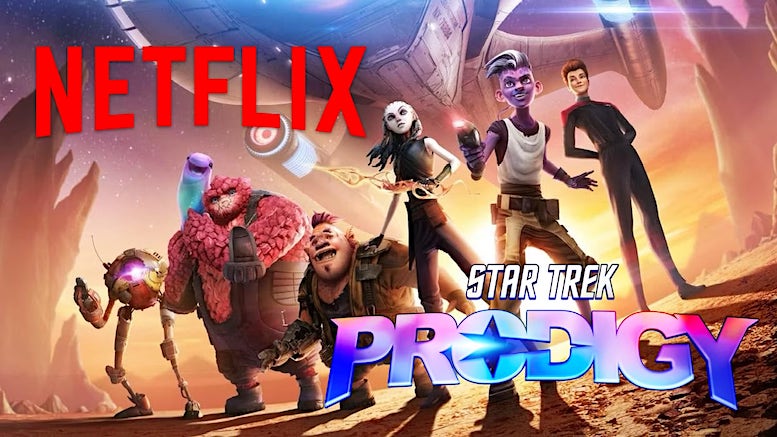
| May 22, 2024 | By: TrekMovie.com Staff 24 comments so far
Last fall, when Netflix announced they were picking up the animated series Star Trek: Prodigy after it had been removed from Paramount+, fans were elated. They also celebrated the worldwide streaming re-release of the first season on Christmas Day. Netflix confirmed they would release the second season in 2024. As the wait continues, producers are urging fans to remain patient.
Season 2 is “worth the wait”
It has now been around five months since the Netflix re-release of the first season of Prodigy , which originally wrapped up on Paramount+ in December 2022. Work on the second season wrapped up at the beginning of 2024. Now fans are starting to wonder how much longer they have to wait. The frustration is understandable, especially after the unexpected early release of season 2 on French TV (dubbed in French) in March.
Executive producers and showrunners Dan and Kevin Hageman took to Twitter/X this week to let fans know they understand. Responding to a fan asking about season 2, they said they were “holding tight like everyone else,” but also promised the second season is “worth the wait.”
we’re holding tight just like everyone else, but we know it’s worth the wait. :) — Dan & Kevin Hageman (@brothershageman) May 20, 2024
Last week, co-executive producer Aaron Waltke also expressed a similar sentiment, posting a clip from Star Trek: Picard quoting Krinn saying “Patience brings great rewards,” adding “Words to live by.”
Words to live by. pic.twitter.com/wNId29MDiw — Aaron J. Waltke (@GoodAaron) May 15, 2024
Season 2 is not coming in June
Even though Netflix and Paramount+ are separate streaming services, there may be coordination to avoid any overlap with the release of Star Trek content, all of which is produced by CBS Studios. The fifth season of Discovery wraps up on Paramount+ next week, on May 30th. The fifth and final season of the animated comedy Star Trek: Lower Decks is expected later this year. Typically, new seasons of Lower Decks have arrived at the end of summer, but last year’s SAG strike delayed some of the voice acting and that might have had an impact on their release timing. Netflix just announced its lineup for June 2024 and Prodigy season 2 is not listed, so the wait will continue into the summer and possibly beyond.
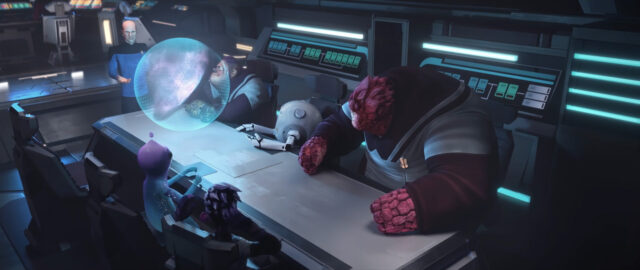
The Doctor (Robert Picardo) gives the provisional cadets a briefing in image from season 2
Watching season 1 on Netflix helps
Hopefully, when the time comes, Netflix will make an effort to promote the second season of Prodigy with a publicity campaign. So far all we have is a clip released by CBS last summer (before the Netflix deal was announced). The producers have all made it clear that Netflix could commission a third season if the show performs well on its new streaming home.
One way fans can show support for the show is by watching the first season on Netflix. One of the fans behind last year’s #SaveStarTrekProdigy campaign is rallying fellow fans around celebrating the show by watching it on Netflix this Sunday, May 26th, in an effort to show the algorithm how much love there is for the series.
We’re making May 26th a big day of celebrating #StarTrekProdigy and everything we love about it. Get your stuff ready, and we’ll show our love and get Netflix’s attention at the same time. #StarTrek #Animation #Netflix — Captain Meg 🟡🟡🟡🟡 (@Commander_Meg) May 17, 2024
Keep up with news about the Star Trek Universe .
Related Articles
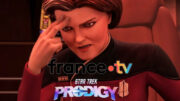
Star Trek: Prodigy
‘Star Trek: Prodigy’ Creators Say “Miscommunication” Led To Unexpected Early Release Of Season 2 In France
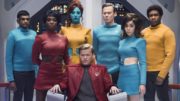
The ‘Black Mirror’ Star Trek-Inspired ‘USS Callister’ Is Getting A Sequel

All Access Star Trek Podcast , Discovery , Lower Decks , Star Trek: Picard , Star Trek: Prodigy , Starfleet Academy , Strange New Worlds
Podcast: All Access Goes To SXSW For The ‘Star Trek: Discovery’ Season 5 Premiere
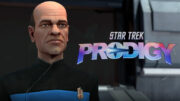
Conventions/Events/Attractions , Star Trek: Prodigy , VOY
Robert Picardo Says The Doctor Isn’t Just Comic Relief In ‘Star Trek: Prodigy’ Season 2
Netflix just released its June line-up. No Prodigy.
I’m *hoping* that Netflix made some handshake deal with Paramount not to draw attention away from Disco S5, and that’s why we haven’t heard anything yet.
Can’t wait for this! Have enjoyed enjoy most of the modern shows with my fave being Lower Decks, but I think the writing on Prodigy has been the best.
I’m trying to maintain my patience, even though it’s gotten tougher since the French release. Even if we don’t get a June release, I did have the thought that we could at least hear something then, since that’s when they usually have their Tudum event which seems like the perfect place to show it off. Here’s hoping.
My hope is that Netflix are biding their time and working with Paramount to launch Prodigy effectively and properly, in a way it should have always been done; branded and marketed to a younger demographic and families around the world. Much in the same way the 2009 movie was launched with a barrage of campaigns and merchandising – Playmates Toys, where are you with the Prodigy toys… hopefully this break gives Netflix the chance to get Playmates Toys onboard, and actually make a go of this new series which will be the key to introducing Star Trek to kids. It has to succeed if Star Trek is to live in the minds of those who are going to shape the future. Prodigy needs to work for Star Trek to remain relevant
I hope you’re right. No one in my family are kids and we all love it, tho, so I hope EVERYONE watches it. Esp the second half of season one was excellent. I keep thinking the biggest mistake Paramount and the writers made was keeping real Janeway a surprise. I’m remember reading Kate would be back…but for a hologram with a bunch of kids and just being like, oh. Deflated. It’s not must-see for Voy fans. And then it WAS, and I enjoyed the twists and all and b/c I always give any new Trek a try I was literally there for it, but it felt like maybe people checked out before then, when not only Janeway appeared but the show got much more complex and Trek-y. I hope they can find the balance of getting the kids in there but also letting adults know this is vital, exciting Trek storytelling.
So what Happens, when a fan loses patience? Not watching it? I doubt that.
They rant on the internet
Literally two comments down someone saying they won’t watch it b/c it’s been so long. So, yes. Streamers and networks very much do lose viewers for having shows on long breaks. People forget what happened previously, people feel like the “buzz” is gone, they lose interest despite reporting having “loved” the previous season, etc.. I have actually seen multiple threads of people talking about wanting to go back to life with 22 episode per season shows on network simply b/c they want to watch the same show every week where the same thing happens every week and there are only a couple breaks in the year. Not breaks that TAKE years. I’m not talking Trek fans specifically here, but we need casuals to tune into things for them to survive. I think people are lazy, tasteless, and full of it wanting to go back to crap network tv, but it’s still a reality right now.
Kid watched season 1 and liked it. The wait between part 1-2 was too long for what they said was a kids show. Prolly why they cancelled it
I made my 4 nephews watch it. They found it boring and ‘tame’. So they all went back to playing their violent computer games.
They better still release season 2 on blu-ray as it will be the only way I can see it as I do not have netflix and never have had it and never will have it they are on my permanent boycot list for multiple reasons one for not canceling and removing all of the homophobic and transphobic stand up comedian’s crap from the service and for getting rid of password sharing and being far to expensive compared to other streaming services Plus Netflix has never had enough content I would want to watch that I don’t have on physical media or on other services
They’ve done releases of some of their shows, like Sandman (which is so good.) But not everything, ob. Fingers crossed they’ll feel like Trek has enough of a fanbase to justify producing some discs.
I have a feeling paramount home video will the ones to release it like they do with other releases and I know the dubbedPokémon anime seasons and movies that are on netflix first end up not being released by Netflix but the Pokémon company who owns and makes the show as Netflix is just the international distributor for it
Alright, I think this means I’m going to mordre la balle and watch this sucker in French.
Why? Because they politely asked you not to?
The show is zombie at this point. I doubt I’m going to even bother watching.
By all accounts, the second season is excellent and wraps up the story in a compelling way, with the possibility for more if it does well.
Did you say the same thing when TNG, DS9 or TOS were announced to be in their final seasons?
I can’t wait for S2. Prodigy and LDS are the only trek I watch now. I’m looking forward to it! Prodigy rocks!
Funny I asked about this the other day and a bit frustrating but not the end of the world. But this is the definitely the show I’m looking forward to and hopefully we will hear something soon.
And really do think it will be worth the wait! 😊
All I got from this is that “Rory The Nerd” needs to get outside and get some air. And perhaps a girlfriend?
It’s a TV show. It’ll come back. Just relax.
It’ll be canceled without passionate fans, so have a little respect.
I’m starting to feel a bit of despair, tbh. I love this show but it feels like Netflix doesn’t. When will they promote it? Give us some kind of REAL update? I’m sure it’ll be worth the wait and I’m glad they didn’t just drop it with no fanfare b/c of the French mistake…but still. I rewatched season one as soon as it came out on Netflix and it feels like forever ago.
Netflix rarely promotes their shows until the month it premieres, because they need to keep the hype going.
Season one came out on Netflix over Christmas, it hasn’t been that long.
I’d love to have the “patience” they’re asking us to have, but it’s almost 3 months since the release in France. Also I looked up the shows/movies Netflix has bothered to give us dates for, ang all the way through to the end of 2024, Prodigy is nowhere on said list. Instead it’s on a seperate list on the same web page that says shows with no date. All it says is 2024. Yeah well where halfway through 2024 and nothing. I also heard that someone said something about it being released in Spring 2024. Well…Spring is ending, and it’s not being released in June, so that was obviously either a guess, or Netflix actually said this somewhere and I haven’t been able to find it, which would mean they lied, but wouldn’t surprise me. Now, if Netflix would have at the very least shown us a 10 second clip with the logo of the show and the words “Coming Soon” like they do with pretty much most of their own productions, then i’d have been happy with that. But they didn’t, and instead have given us silence. So this “patience” they want us to have? Sorry but for me that “patience” left the building, went to Kennedy Space Center, blasted off on one of the SpaceX rockets, and then from there left for outer space (AKA it’s gone, obviously, but I figured the space reference was appropriate). Will I still watch it when it finally does drop? Yes. Will I hold my breath and still be patient? Definitely not. Instead I will be giving my attention to The Acolyte on Disney+ in June. I’d watch Prodigy Season 2 first, but of course they wont let us see it so, The Acolyte it is.
The New Star Trek Movie Is A Prequel – But Will It Rewrite The Franchise Timeline?
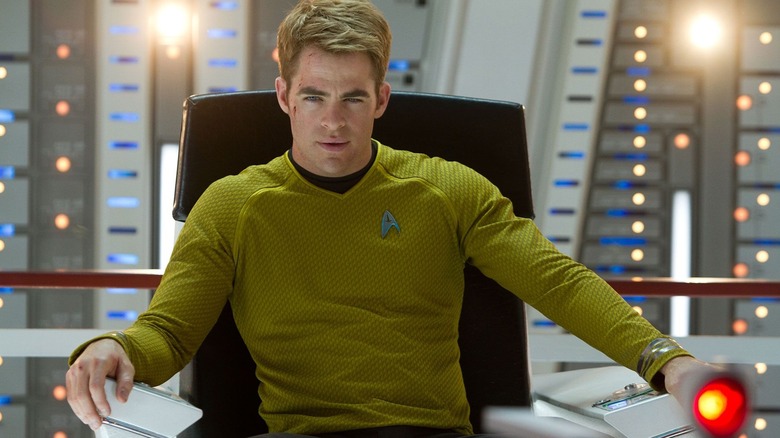
It was announced today in the Hollywood Reporter that Simon Kinberg is taking over the development of the new "Star Trek" feature film, currently working its way through pre-production at Paramount. This new film will be the fourth to be connected to the Kelvin timeline of "Star Trek," a timeline which started with the events of J.J. Abrams' 2009 "Star Trek" film. As of this writing, Toby Haynes ("Andor") is slated to direct, while Seth Grahame-Smith ("Dark Shadows," "The LEGO Batman Movie") has signed on to write. Kinberg is a notable Hollywood player who wrote "X-Men: The Last Stand," "X-Men: Days of Future Past," "X-Men: Apocalypse," and "Dark Phoenix" (among many others) and who produced "The New Mutants," "Deadpool," "Logan," "X-Men: First Class," "Cinderella," "The Martian," and "Elysium" (among many others). He is a franchise guy through-and-through, and Paramount likely wanted a new producer with high-profile experience.
It has been reported that the new "Star Trek" movie will, to quote the Hollywood Reporter, "be set decades before the events of the 2009 movie that was directed J.J. Abrams , likely around modern times." They added that it "is said to involve the creation of the Starfleet and humankind's first contact with alien life."
These declarations will have some Trekkies' minds at yellow alert. As we all know, the Kelvin universe was an alternate timeline created by the time-travel shenanigans of a vengeful Romulan named Nero (Eric Bana). The timeline diverged when Nero appeared through a time portal in front of the U.S.S. Kelvin ... right when James T. Kirk was being born. Trekkies will happily leap in and point out that Kirk was born in 2233 ... but that First Contact — as dramatized in "Star Trek: First Contact" — took place in 2063.
Is Trek history being entirely re-written?
The timeline of Star Trek
To offer a brief timeline of events in the "Star Trek" universe, humanity was facing down some harrowing times in the late 20th century, and the world broke out into a series of devastating wars. First, there were the Eugenics Wars, in which tyrannical genetically selected supermen became global dictators. Audiences know about the Eugenics Wars through Khan (Ricardo Montalban), one of said dictators. Then there was the Second Civil War, talked about in a time-travel episode of "Star Trek: Deep Space Nine," which exacerbated poverty and misery on Earth, followed finally by World War III, which lasted from 2026 to 2053. World War III left humanity scattered and hopeless.
This was all before humanity had discovered faster-than-light travel, and trekking through the stars hadn't yet begun.
The statement that the new Trek movie will take place "likely around modern times" would need to place it prior to the above conflicts. It's worth noting that the second season of "Star Trek: Picard" was also a time travel story that took Picard (Patrick Stewart) and his friends back in time to 2024, prior to the Eugenics Wars. So it seems that part of Trek lore might have been covered already. We will have to see if "Star Trek 4" will take place before or after "Picard."
But that timeline couldn't incorporate First Contact.
It wouldn't be until 2063 that Zefram Cochrane (James Cromwell) would invent faster-than-light travel. The maiden voyage of his ship, the Phoenix, would attract a Vulcan vessel coincidentally passing by Earth. The Vulcans would land and initiate First Contact, ushering a new phase of peace on Earth. It was with First Contact that Trek's optimistic future would begin.
Will Kinberg's new film time-shift First Contact backward?
Is First Contact being time-shifted?
Continuing with Trek's timeline, First Contact allowed humanity to realize the errors of their warlike ways, and begin rebuilding after World War III, now with the Vulcans' help. This period would take the better part of a century, and humanity wouldn't be able to launch their own ship — the Enterprise — until the year 2151. The first adventures of the first Enterprise were dramatized in "Star Trek: Enterprise."
Kinberg's film could conceivably take place during the century after First Contact, but before the launch of the first Enterprise, although that timeframe would preclude star trekking; according to "Enterprise," the Vulcans were insistent that humans remain on Earth for 100 years , technologically and philosophically preparing themselves for encountering new life and new civilizations. "Enterprise" would indeed fall in line with "the creation of Starfleet," as stated in the Hollywood Reporter. Starfleet was formed before the launch of the Enterprise, sometime in the 2130s.
It's the "decades before" part that might have some Trekkies looking at the statement a little sideways. Since the Kelvin timeline didn't begin until 2233, the formation of Starfleet would be a full century before the 2009 film, not decades. And First Contact would be almost two centuries before the 2009 film.
Paramount, as of this writing, has not released any additional details about the upcoming film's plot, so we can only speculate as to when it might take place. Will it be a flashback or a time travel plot? But here's a daring thought: Kinberg's new film may openly rewrite Trek continuity and time-shift First Contact to earlier in humanity's timeline.
Gene Roddenberry's penance era
When looking back at the 1960s, when Gene Roddenberry first created "Star Trek," the world was a tumultuous place. Roddenberry looked out the window and saw war, violence, intolerance, and bigotry. He invented "Star Trek" as a reaction to all that, envisioning a future when war was over (because we wanted it), money had been eliminated, and bigotry was dead. But to achieve this utopia, humanity needed to hit a "low point" first. As such, the timeline of Trek required Earth to nearly destroy itself before it could have a moment of clarity.
If Kinberg aims to time-shift First Contact and the formation of Starfleet to the modern era, it would become a fascinating speculation indeed. If "Star Trek" began without the Roddenberrian moment of clarity, would utopia still be achieved? What if we had starships and access to Vulcans today in 2024? Would the utopia of "Star Trek" be kickstarted 200 years early, or would we humans, still presumably warlike, merely struggle through the Eugenics Wars/Second Civil War/World War III up in space instead of on the ground?
And if Kinberg's goal is to shift "Star Trek" history so dramatically, it would mean that he is deliberately erasing the Kelvin timeline. Remember that before the Kelvin timeline split, "Star Trek" was identical in both timelines. "Star Trek: Enterprise" still played itself out as we saw in the 2001 to 2005 TV series, and references to "Enterprise" were made liberally throughout 2016's "Star Trek Beyond," the second sequel to "Star Trek" (2009).
If Kinberg does set the action of his new film in the modern day, "Enterprise" would be retconned entirely ... as would all of "Star Trek."
That's even more daring than the parallel timeline from Abrams' film.
Time will tell.
When is the 'Star Trek: Discovery' Season 5 finale? Release date, cast, where to watch

Warning: May contain spoilers .
U.S.S. Discovery's final mission is almost at its end, with the last episode of "Star Trek: Discovery" Season 5 scheduled to release this Thursday.
The fifth and final season of the hit TV series had followed Captain Burnham and the crew of the U.S.S. Discovery uncover a mystery that sent them on "an epic adventure across the galaxy to find an ancient power whose very existence has been deliberately hidden for centuries," according to Paramount+.
"Star Trek: Discovery" debuted in 2017 and is the seventh in the Star Trek series. Here's what to know about Season 5 of "Star Trek: Discovery," and when the final episode will be dropping.
When is 'Star Trek: Discovery' Season 5 finale?
The final episode of "Star Trek: Discovery" Season 5 will release on Paramount+ on Thursday, May 30. Paramount+ did not specify what time the episode will be available on its platform.
Need a break? Play the USA TODAY Daily Crossword Puzzle.
Nine episodes of Season 5, and Seasons 1 to 4 are available to stream on Paramount+.
'Star Trek: Discovery' on Paramount+: Subscribe
Will 'Star Trek: Discovery' have another season?
No. Paramount+ had earlier announced that Season 5 will be the last in the "Star Trek: Discovery" series.
'Star Trek: Discovery' Season 5 cast
Season 5 of "Star Trek: Discovery" brings back new and old faces along with recurring guest stars. Cast members include:
- Sonequa Martin-Green as Captain Michael Burnham
- Doug Jones as Saru
- Anthony Rapp as Paul Stamets
- Mary Wiseman as Sylvia Tilly
- Wilson Cruz as Dr. Hugh Culber
- David Ajala as Cleveland “Book” Booker
- Blu del Barrio as Adira
- Callum Keith Rennie as Rayner
- Elias Toufexis as L’ak
- Eve Harlow as Moll
'Star Trek: Discovery' Season 5 trailer
Paramount+ dropped the official trailer for Season 5 on Feb. 23.
We occasionally recommend interesting products and services. If you make a purchase by clicking one of the links, we may earn an affiliate fee. USA TODAY Network newsrooms operate independently, and this doesn’t influence our coverage.
Saman Shafiq is a trending news reporter for USA TODAY. Reach her at [email protected] and follow her on X, the platform formerly known as Twitter @saman_shafiq7.
Follow Polygon online:
- Follow Polygon on Facebook
- Follow Polygon on Youtube
- Follow Polygon on Instagram
Site search
- Dragon’s Dogma 2
- Zelda: Tears of the Kingdom
- Baldur’s Gate 3
- Summer Game Fest schedule
- PlayStation
- Dungeons & Dragons
- Magic: The Gathering
- Board Games
- All Tabletop
- All Entertainment
- What to Watch
- What to Play
- Buyer’s Guides
- Really Bad Chess
- All Puzzles
Filed under:
- Entertainment
Netflix’s Eric, Star Trek: Discovery’s series finale, and more new TV this week
Plus: The end of Hulu’s Under the Bridge, Hacks season 3, and more
Share this story
- Share this on Facebook
- Share this on Reddit
- Share All sharing options
Share All sharing options for: Netflix’s Eric, Star Trek: Discovery’s series finale, and more new TV this week
/cdn.vox-cdn.com/uploads/chorus_image/image/73372608/DISCO_509_MAG_1021_01113_1_RT1.0.jpeg)
The week has barely started (if you’re in the U.S. and reading this on the Monday holiday: even less so!), and already there’s a whole lot of TV to get through.
With any luck, the long weekend gave you some time to catch up with things — after all, as our summer preview is any indication, there’s only gonna be even more coming soon. But while a bunch of new stuff might be coming up, there’s plenty to watch this week alone. Under the Bridge and Hacks are both wrapping up really strong seasons, while shows like Pyramid Game and We Are Lady Parts are just ramping up.
Here are all the best new TV premieres and finales this week.
New shows on Netflix
Genre: Drama miniseries Release date: May 30, with all episodes Showrunner/creator: Abi Morgan Cast: Benedict Cumberbatch, Gaby Hoffmann, and more
Vincent (Benedict Cumberbatch) is a puppeteer happily living and working in 1980s New York City. Then, his 9-year-old son goes missing on the way to school, plunging Vincent into a dark, volatile depression. Vincent believes his son will come back if only he can get Eric, a monster based on a drawing his son did, to the screen.
Genre: Teen show Release date: May 30 Based on the book by: Holly Smale Cast: Emily Carey, Sarah Parish, Emmanuel Imani, and more
Harriet (Emily Carey) is just another geek trying to get by in high school, even if it means brushing off some mean girl bullies to do it. But everything changes when — against the odds and Harriet’s wishes — she finds herself scouted to be the next hot supermodel.
New shows on Hulu
The veil season finale.
:no_upscale()/cdn.vox-cdn.com/uploads/chorus_asset/file/25442501/VEIL_0000054.jpg)
Genre: Spy thriller Release date: May 28 Showrunner/creator: Steven Knight Cast: Elisabeth Moss, Yumna Marwan, Josh Charles, and more
The stage is set in London for a deadly attack. But Imogen (Elisabeth Moss) and Adilah (Yumna Marwan) are also on the move. And with Imogen keeping her master plan secret from even us, it seems likely that this attack could go either way.
Under the Bridge finale
:no_upscale()/cdn.vox-cdn.com/uploads/chorus_asset/file/25453519/utb_106_ds_00393rc_3k.jpg)
Genre: True-crime mystery Release date: May 29 Showrunner/creator: Samir Mehta, Quinn Shephard Cast: Lily Gladstone, Riley Keough, and more
There’s nothing about the murder of Reena Virk (Vritika Gupta) that feels easy to swallow, and it’s a testament to Under the Bridge that the show has been able to balance the complexities of that reality in its seven episodes so far. Now, it’s coming to a close — one that no doubt will carry the weight of every ounce of tragedy in this story.
New shows on Max
Hacks season 3 finale.
:no_upscale()/cdn.vox-cdn.com/uploads/chorus_asset/file/25453526/hannah_einbinder_jean_smart_1.jpg)
Genre: Comedy Release date: May 30 Showrunner/creator: Paul W. Downs, Lucia Aniello, and Jen Statsky Cast: Hannah Einbinder, Jean Smart, and more
It’s all happening for Deborah (Jean Smart), now that she finally got her dream of hosting a late-night show. Only suddenly, there’s some last-minute doubt: Will Ava (Hannah Einbinder) be allowed to come along for the ride?
New shows on Paramount Plus
Pyramid game.
Genre: Thriller Release date: May 30, with all 10 episodes Showrunner/creator: Choi Sui Cast: Bona, Jang Da-a, Ryu Da-in, and more
Seong Su-ji is a new student at the Baekyeon Girls’ High School, and everything is already feeling like a fight for survival as she battles bullies and studies alike. And then she’s introduced to a new ranking system that lets people secretly vote for who they think should be a class outcast. Now, Su-ji has to decide whether to keep going along (and possibly accepting the violence that comes with it) or else lead an uprising against this shadowy “Pyramid Game.”
Star Trek: Discovery series finale
:no_upscale()/cdn.vox-cdn.com/uploads/chorus_asset/file/25437335/DISCO_506_MAG_0914_12774_1_RT1.jpeg)
Genre: Star Trek Release date: May 30 Showrunner/creator: Akiva Goldsman Cast: Sonequa Martin-Green, Mary Wiseman, Doug Jones, and more
The end of an era! By which I mean not only the season we got of 900 years in Star Trek’s future, but also Discovery , which wraps up this Thursday. It’s the end of the first Star Trek show of the modern era, and is free in a way Star Trek hasn’t been in a long, long while , all while paving the way for more Trek to come.
New shows on Peacock
We are lady parts season 2.
Genre: “Yeah, I’m in a band” teen comedy Release date: May 30, with all episodes Showrunner/creator: Nida Manzoor Cast: Anjana Vasan, Sarah Kameela Impey, Juliette Motamed, and more
We Are Lady Parts is back and ready to record their debut album. Which means it’s the perfect time for more bandmate shenanigans — including battling a rival Muslim band, playing a festival, exploring your “villain era.” All that and Malala Yousafzai is supposed to show up sometime this season!
New shows on Apple TV Plus
Loot season 2 finale.
Genre: Comedy Release date: May 29 Showrunner/creators: Alan Yang and Matt Hubbard Cast: Maya Rudolph, Joel Kim Booster, Nat Faxon, and more
The Wells Foundation — and Molly (Maya Rudolph), the billionaire woman who runs it — are nearing their greatest success yet. Which, of course, means reality is about to come crashing in with some major personal decisions. How will the dust settle in the season 2 finale?
New shows on Showtime
Couples therapy season 4.
Genre: Documentary series Release date: May 31, with one episode; on-air premiere at 10 p.m. EDT on June 2 Showrunner/creator: Dr. Orna Guralnik Cast: Real-life couples in therapy
It’s a new season of Couples Therapy, and an all-new cast of couples to undergo real therapy with Dr. Orna. The result will be unpredictable — couples therapy, after all, is about figuring yourselves out together, not necessarily saving the relationship. The good news? It will most likely be cathartic, one way or another.
The next level of puzzles.
Take a break from your day by playing a puzzle or two! We’ve got SpellTower, Typeshift, crosswords, and more.
Sign up for the newsletter Patch Notes
A weekly roundup of the best things from Polygon
Just one more thing!
Please check your email to find a confirmation email, and follow the steps to confirm your humanity.
Oops. Something went wrong. Please enter a valid email and try again.
Loading comments...

Tiana’s Bayou Adventure looks better than Splash Mountain, see for yourself

Lara Croft roars in the first trailer for Netflix’s Tomb Raider anime

In a Violent Nature almost made me physically ill, and I loved it

Halt and Catch Fire understood video games better than any other show

Pokémon Go raid schedule for June 2024’s Legendary and Mega Pokemon

Every movie and show coming to Netflix in June

IMAGES
VIDEO
COMMENTS
Star Trek Continues is an American fan-made web series set in the Star Trek universe. Produced by the nonprofit Trek Continues, Inc. and Dracogen, and initially co-produced by Far from Home LLC and Farragut Films (who previously produced a fan-made "Starship Farragut" series), Star Trek Continues consists of 11 episodes released between 2013 and 2017. The series is an unofficial direct ...
Star Trek Phase II: Created by Gene Roddenberry. With Charles Root, John M. Kelley, James Cawley, Jeff Mailhotte. These are the new voyages of the starship Enterprise. Picking up from where the original 5-year mission left-off, a new cast continues the adventures of this legendary crew: to boldly go where no human has ever gone before & to search for new life forms.
Thanks! Star Trek Continues is eleven episodes, was created by and stars Vic Mignogna, and ran from 2013 to 2017; Star Trek: New Voyages was originally called Star Trek: Phase II, but changed the name at Paramount's request. There are ten episodes, the series was created by and originally starred James Cawley, and it ran from 2004 to 2016.
This is the the official Star Trek New Voyages: Phase II - International YouTube Channel, run by www.stnv.de. We offers all Star Trek New Voyages / Phase II episodes with subtitles in English (UK ...
Star Trek Continues: With Vic Mignogna, Todd Haberkorn, Christopher Doohan, Grant Imahara. The further adventures of the crew of the USS Enterprise.
Share your videos with friends, family, and the world
Star Trek Continues Phase 2. FREE NO-ADS, exclusive shows from fan-owned studios, include New Voyages, and STC vignettes, Music, and a rotation of new videos.
Star Trek: New Voyages, known from 2008 until 2015 as Star Trek: Phase II, is a fan-created science fiction webseries set in the fictional Star Trek universe. The series was designed as a continuation of the original Star Trek (aka ST:TOS or just TOS), beginning in the fifth and final year of the starship Enterprise's "five-year mission." The first episode was released in January 2004, with ...
The STAR TREK CONTINUES webseries boldly completes the original five-year mission. Below, you can find all of our episodes, vignettes, and other content — including behind-the-scenes videos, set walk-throughs, and much more. EPISODE 1 "PILGRIM OF ETERNITY" EPISODE 2 "LOLANI" EPISODE 3 "FAIREST OF THEM ALL" Apollo returns to wreak ...
Star Trek: Phase II was the initial working title for what officially became titled Star Trek II, an unproduced American science fiction television series created by Gene Roddenberry as a sequel to (and continuation of) the original Star Trek, which had run from 1966 to 1969.The plans for the series were first developed after several failed attempts to create a feature film based on the ...
Beaming up a new transporter room. Star Trek: Phase II. The warehouse in which the sets are being built covers 13,000 square feet. The bridge, corridors, and transporter room are pretty much ...
Star Trek: Phase II, also known by its official title Star Trek II (not to be confused with the earlier 1975-1976 revitalization attempts bearing the same title), was planned to be the first live-action spin-off television series of Star Trek: The Original Series. While ultimately not realized, it did serve, in more ways than one, as the starting point for its immediate successor Star Trek ...
Star Trek and all related marks, logos and characters are solely owned by CBS Studios Inc. This fan production is not endorsed by, sponsored by, nor affiliated with CBS, Paramount Pictures, or any other Star Trek franchise, and is a non-commercial fan-made film series intended for recreational use. No commercial exhibition or distribution is ...
In fact, VIC MIGNGNA, the show-runner behind Star Trek Continues, actually got his start in Trek fan films directing and guest-starring in one of Phase II's most ambitious productions, an episode called "Kitumba." STAR TREK: NEW VOYAGES/PHASE II (top) had a wide-screen 16×9 aspect ratio. STAR TREK CONTINUES opted for a 4×3 aspect ratio.
The continuing voyages of Captain Kirk and the crew of the U.S.S. Enterprise, NCC-1701 as seen in the 1966-69 television series, Star Trek. The series was cancelled after its third season. We are ...
Star Trek Phase 2 - Special Featurette. 04xV1 - Center Seat. 04xV2 - No Win Scenario. 04xV3 - 1701 Pennsylvania Av. 04xV4 - Going Boldly. 4×00 - Come What May. 4×01 - In Harm's Way - Directors Cut. 4×02 - To Serve All My Days. 4×03 - World Enough and Time.
S4.E0 ∙ Come What May. Fri, Jan 16, 2004. After receiving a distress call, the USS Enterprise, commanded by Captain James T. Kirk , is assigned to investigate an intruder attacking the Primus IV colony. Once there, the crew encounters a strange alien life form that can produce visions of personal events displaced in time.
Star Trek: Phase II concept art and history. TOS; Phase II; Films. The Motion Picture; The Wrath of Khan; Other Movies; TNG; DS9; VOY; Fandom; Phase II. Production. Making Phase II; Planet of the Titans; The Billion Year Voyage; Visions of the Future; Lost Episodes. In Thy Image; Lord Bobby's Obsession; The Prisoner; To Attain the All;
Star Trek: Phase II (ST:PII) Originally called 'Star Trek: New Voyages,' Star Trek: Phase II was the first serious undertaking, beginning production in 2003. It is Produced by James Cawley, who also plays Captain Kirk in the currently-released episodes. Some of the episodes were new screenplays written by original Star Trek screenwriters like ...
The premise of Star Trek: Phase II was simple: A returning Captain Kirk (William Shatner) was to merely start on another five-year mission onboard a newly retrofit Enterprise (designed by Star ...
After several attempts to bring Star Trek to the silver screen, Paramount decided in 1977 to produce a second television series, called Phase II.. Barry Diller, Paramount's president, had been concerned about the direction in which Chris Bryant and Allan Scott were taking the franchise with their script for the proposed movie Planet of the Titans.He turned to Gene Roddenberry and suggested ...
The project will launch executive producer Alex Kurtzman's "Phase 2" of his Paramount+ Trek franchise master plan. ... Paramount+'s Star Trek news continues with the trailer for 'Strange New ...
Watching season 1 on Netflix helps. Hopefully, when the time comes, Netflix will make an effort to promote the second season of Prodigy with a publicity campaign. So far all we have is a clip ...
It has been reported that the new "Star Trek" movie will, to quote the Hollywood Reporter, "be set decades before the events of the 2009 movie that was directed J.J. Abrams, likely around modern ...
52:39. April 5, 2012. ( 2012-04-05) 9717.7. Originally a script for the unproduced TV series, Star Trek: Phase II, in 1977 and later reworked into the first episode of the second season of Star Trek: The Next Generation, albeit with a simplified plot. Now being developed as it was originally written. Guest starring:
Season 5 of "Star Trek: Discovery" brings back new and old faces along with recurring guest stars. Cast members include: Sonequa Martin-Green as Captain Michael Burnham. Doug Jones as Saru ...
Genre: Thriller. Release date: May 30, with all 10 episodes. Showrunner/creator: Choi Sui. Cast: Bona, Jang Da-a, Ryu Da-in, and more. Seong Su-ji is a new student at the Baekyeon Girls' High ...